Hotpoint FK 89E X, FK 996E C X User Manual

Operating Instructions
GB |
|
FR |
|
ES |
|
|
|
|
|
|
|
English,1 |
Français, 16 |
Espanol, 31 |
|||
|
|
|
|
|
|
PT |
|
AR |
|
|
|
|
|
|
|
|
|
Portuges, 46 |
|
|
|
|
|
FK 89E X
FK 996ESC X
FK 89E
FK 996ESC
FK 996E C X
OVEN
Contents
GB
Installation, 2-3
Positioning Electrical connection Technical data
Description of the appliance, 4
Overall view
Control panel
Display
Start-up and use, 5-6
Control panel lock
Setting the clock
Setting the minute minder
Starting the oven
Restoring the factory settings
Standby
Modes, 7-10
Manual cooking modes
Automatic cooking modes
Programming cooking
Practical cooking advice
Cooking advice table
Precautions and tips, 11
General safety
Disposal
Respecting and conserving the environment
Care and maintenance, 12-13
Switching the appliance off
Cleaning the appliance
Cleaning the oven door
Replacing the light bulb
Assembling the sliding rack kit
Troubleshooting, 14
Assistance, 15
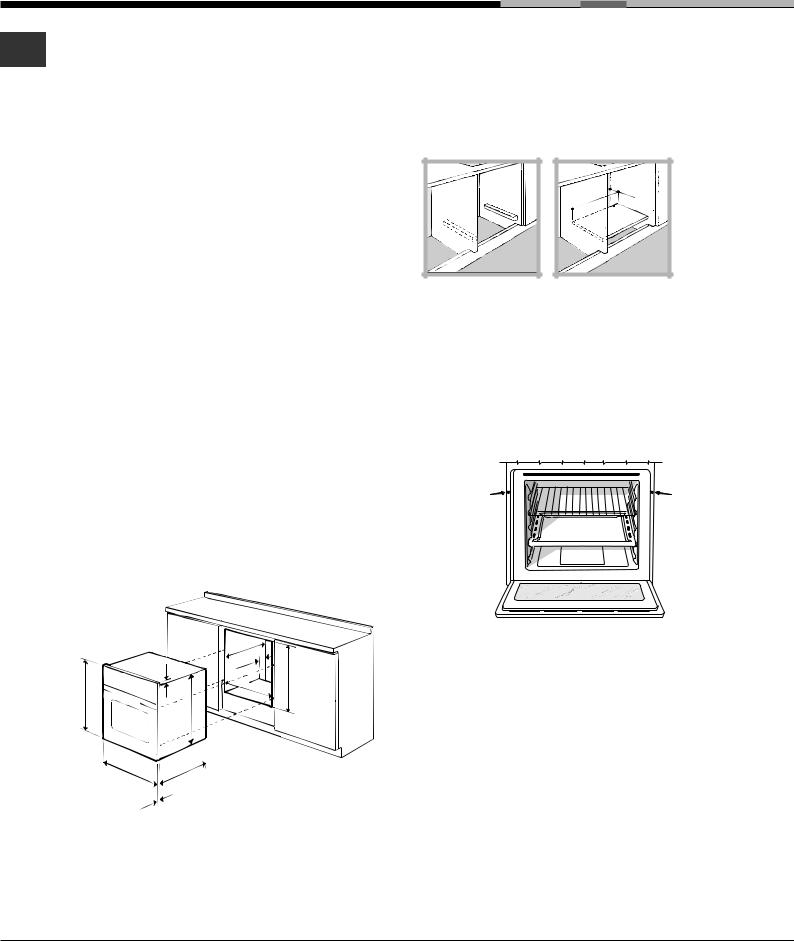
Installation
! Please keep this instruction booklet in a safe place GB for future reference. If the appliance is sold, given
away or moved, please make sure the booklet is also passed on to the new owners so that they may benefit from the advice contained within it.
! Please read this instruction manual carefully: it contains important information concerning the safe operation, installation and maintenance of the appliance.
Positioning
!Do not let children play with the packaging material; it should be disposed of in accordance with local separated waste collection standards (see Precautions and tips).
!The appliance must be installed by a qualified professional in accordance with the instructions provided. Incorrect installation may damage property or cause harm to people or animals.
Built-in appliance
Use an appropriate cabinet to ensure that the appliance operates properly:
•The panels adjacent to the oven must be made of heat-resistant material.
•Cabinets with a veneer exterior must be assembled with glues which can withstand temperatures of up to 100°C.
•to install the oven under the counter (see diagram) or in a kitchen unit, the cabinet must have the following dimensions:
Ventilation
To ensure adequate ventilation is provided, the back panel of the cabinet must be removed. It is advisable to install the oven so that it rests on two strips of wood, or on a completely flat surface with an opening of at least 45 x 560 mm (see figures).
. |
45 |
mm |
. |
mm |
|
||
560 |
|
|
|
Centring and fixing
Secure the appliance to the cabinet:
•Open the oven door.
•Remove the 2 rubber plugs covering the fixing holes on the perimeter frame.
•Fix the oven to the cabinet using the 2 wood screws.
•Replace the rubber plugs.
|
|
|
. |
|
|
|
mm |
mm.590 |
20mm. |
mm.570 |
550 . |
585-575mm. |
|||
|
|
|
min |
|
|
|
. |
|
|
|
mm |
|
|
|
45 |
560 |
mm. |
|
595 |
mm. |
|
. |
|
mm |
||
|
|
550 |
. |
|
|
mm |
|
|
|
|
.* |
|
|
20,5 mm |
|
|
|
22,5 |
|
* Stainless steel models only
! The appliance must not come into contact with electrical parts once it has been installed.
The indications for consumption given on the data plate have been calculated for this type of installation.
! All parts which ensure the safe operation of the appliance must not be removable without the aid of a tool.
2
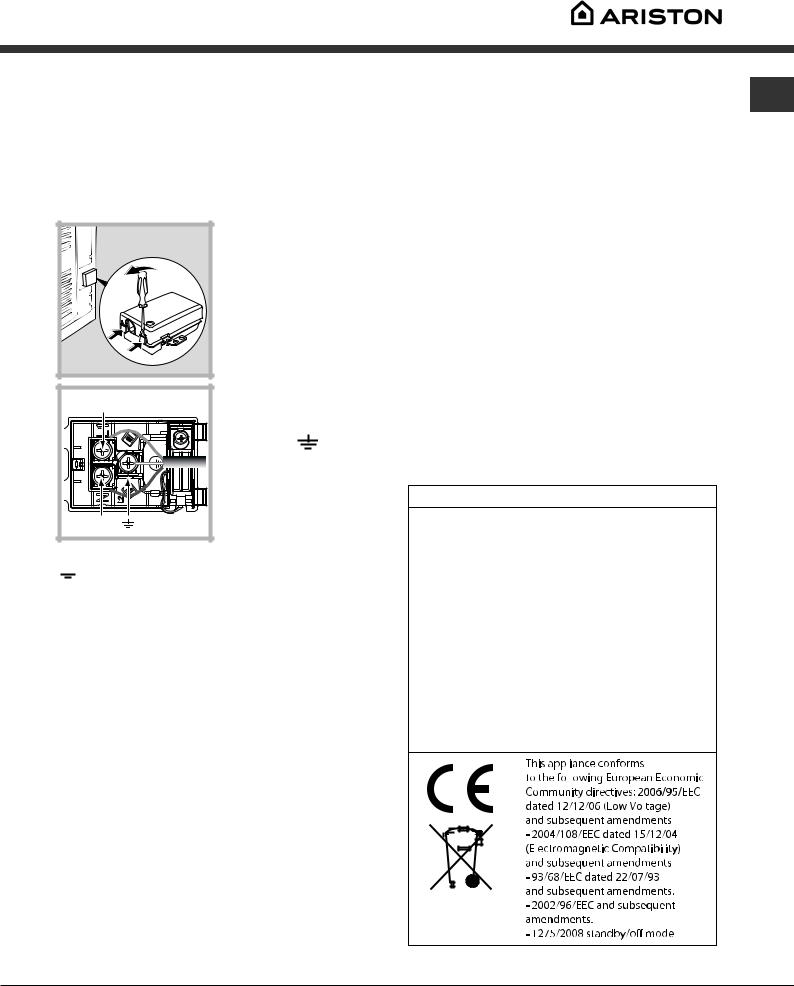
Electrical connection
! Ovens equipped with a three-pole power supply cable are designed to operate with alternating current at the voltage and frequency indicated on the data plate located on the appliance (see below).
Fitting the power supply cable
|
1. Open the terminal |
|
board by inserting a |
|
screwdriver into the |
|
side tabs of the cover. |
|
Use the screwdriver as |
|
a lever by pushing it |
|
down to open the cover |
|
(see diagram). |
|
2. Install the power |
|
supply cable by |
L |
loosening the cable |
clamp screw and the |
|
|
three wire contact |
|
screws L-N- . |
|
Connect the wires to the |
|
corresponding |
|
terminals: the Blue wire |
|
to the terminal marked |
N |
(N), the Brown wire to |
|
the terminal marked (L) |
and the Yellow/Green wire to the terminal marked  (see diagram).
(see diagram).
3.Secure the cable by fastening the clamp screw.
4.Close the cover of the terminal board.
Connecting the electricity supply cable to the mains
Install a standardised plug corresponding to the load indicated on the data plate (see table). The appliance must be directly connected to the
mains using an omnipolar switch with a minimum contact opening of 3 mm installed between the appliance and the mains. The switch must be suitable for the charge indicated and must comply with current electrical regulations (the earthing wire must not be interrupted by the switch). The supply cable must be positioned so that it does not come into contact with temperatures higher than 50°C at any point (the back panel of the oven, for example).
! The installer must ensure that the correct electrical connection has been performed and that it is fully compliant with safety regulations.
Before connecting the appliance to the power
supply, make sure that: |
GB |
|
•the appliance is earthed and the plug is compliant with the law;
•the socket can withstand the maximum power of the appliance, which is indicated on the data plate (see below);
•the voltage is in the range between the values indicated on the data plate (see below);
•the socket is compatible with the plug of the appliance. If the socket is incompatible with the plug, ask an authorised technician to replace it. Do not use extension cords or multiple sockets.
!Once the appliance has been installed, the power supply cable and the electrical socket must be easily accessible.
!The cable must not be bent or compressed.
!The cable must be checked regularly and replaced by authorised technicians only (see Assistance).
!The manufacturer declines any liability should these safety measures not be observed.
APPLIANCE SPECIFICATIONS
Dimensions |
width 43.5 cm |
||||||||||||||||
height 32 cm |
|||||||||||||||||
|
|
|
|
|
|
|
|
|
|
|
depth 41.5 cm |
||||||
|
|
|
|
|
|
|
|
|
|
|
|
|
|
|
|
|
|
Volume |
58 l |
||||||||||||||||
|
|
|
|
|
|
|
|
|
|
|
|
|
|
|
|
|
|
Electrical |
voltage: 220 - 240 V~ 50/60 Hz |
||||||||||||||||
(see data plate) |
|||||||||||||||||
connections |
maximum power absorbed |
||||||||||||||||
|
|
|
|
|
|
|
|
|
|
|
2800 W |
||||||
|
|
|
|
|
|
|
|
|
|
|
|
|
|
|
|
|
|
|
|
|
|
|
|
|
|
|
|
|
Directive 2002/40/EC on the label |
||||||
|
|
|
|
|
|
|
|
|
|
|
of electric ovens. Standard EN 50304 |
||||||
ENERGY |
Declared energy consumption |
||||||||||||||||
LABEL* |
for Forced convection Class – |
||||||||||||||||
|
|
|
|
|
|
|
|
|
|
|
heating mode: |
||||||
|
|
|
|
|
|
|
|
|
|
|
ECO. |
||||||
|
|
|
|
|
|
|
|
|
|
|
|
|
|
|
|
|
|
|
|
|
|
|
|
|
|
|
|
|
|
|
|
|
|
|
|
|
|
|
|
|
|
|
|
|
|
|
|
|
|
|
|
|
|
|
|
|
|
|
|
|
|
|
|
|
|
|
|
|
|
|
|
|
|
|
|
|
|
|
|
|
|
|
|
|
|
|
|
|
|
|
|
|
|
|
|
|
|
|
|
|
|
|
|
|
|
|
|
|
|
|
|
|
|
|
|
|
|
|
|
|
|
|
|
|
|
|
|
|
|
|
|
|
|
|
|
|
|
|
|
|
|
|
|
|
|
|
|
|
|
|
|
|
|
|
|
|
|
|
|
|
|
|
|
|
|
|
|
|
|
|
|
|
|
|
|
|
|
|
|
|
|
|
|
|
|
|
|
|
|
|
|
|
|
|
|
|
|
|
|
|
|
|
|
|
|
|
|
|
|
|
|
|
|
|
|
|
|
|
|
|
|
|
|
|
|
|
|
|
|
|
|
|
|
|
|
|
|
|
|
|
|
|
|
|
|
|
|
|
|
|
|
* Without removable guide rails
3
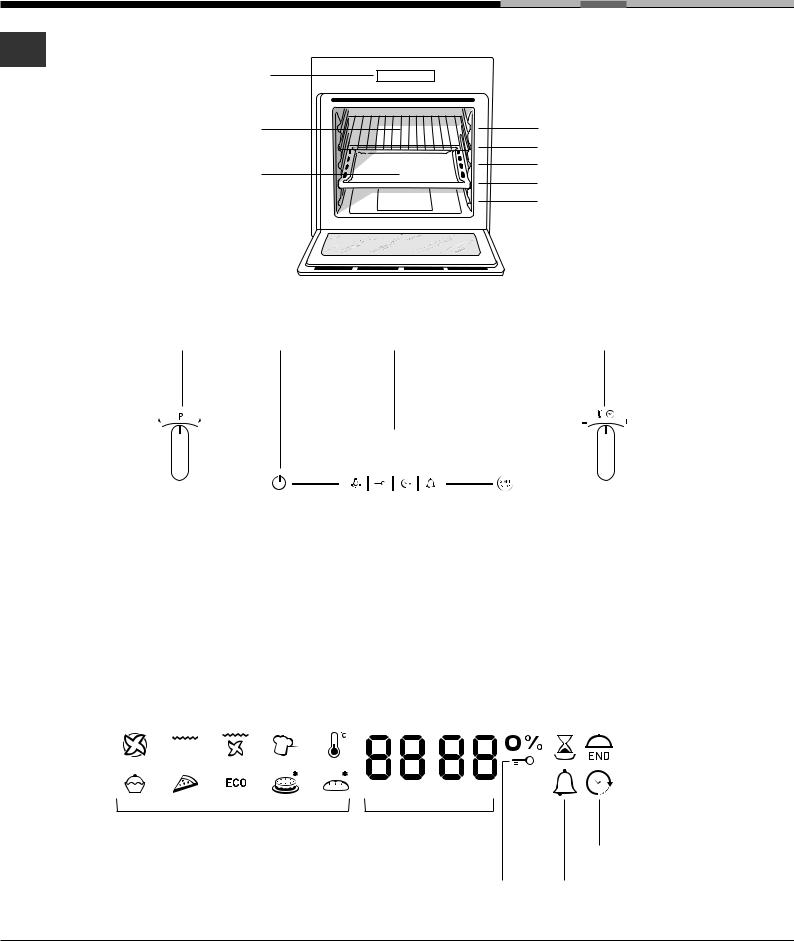
Description of the appliance
Overall view
GB
Control panel |
GUIDES for the |
|
|
sliding racks |
|
GRILL |
position 5 |
|
|
position 4 |
|
DRIPPING PAN |
position 3 |
|
position 2 |
||
|
||
|
position 1 |
Control panel
SELECTOR |
CONTROL |
DISPLAY |
THERMOSTAT / |
knob |
PANEL |
|
TIMER |
|
POWER BUTTON |
|
knob |
|
|
|
|
|
|
|
|
|
|
|
|
|
|
|
|
|
|
|
|
|
|
|
|
|
|
|
|
|
|
|
|
|
|
|
|
|
|
|
|
|
|
|
|
|
|
|
|
|
|
|
|
|
|
|
|
|
|
|
|
|
|
|
|
|
|
|
|
|
|
|
|
|
|
|
|
|
|
|
|
|
|
|
|
|
|
|
|
|
|
|
|
|
|
|
|
|
|
|
|
|
|
|
|
|
|
|
|
|
|
|
|
|
|
|
|
|
|
|
|
|
|
|
|
|
|
|
|
|
|
LIGHT |
|
|
|
|
|
|
|
|
|
|
|
|
|
|
|
START / |
|
|
|
|
||||
|
|
|
|
|
|
icon |
|
|
|
|
|
|
|
|
|
|
|
|
|
|
|
STOP |
|
|
|
|
||||
|
|
|
|
|
|
|
|
|
|
|
|
|||||||||||||||||||
|
|
|
|
CONTROL PANEL LOCK |
|
|
|
|
|
|
|
|
|
|
|
|
|
|
|
|
|
|
|
|
|
|||||
|
|
|
|
|
|
icon |
|
|
|
|
|
|
|
|
|
|
|
|
|
|
|
|
|
|
|
|
|
|||
|
|
|
|
|
|
|
|
TIMER |
|
|
|
MINUTE MINDER |
|
|
|
|
||||||||||||||
|
|
|
|
|
|
|
|
|
|
|
icon |
|
|
|
|
|||||||||||||||
|
|
|
|
|
|
|
|
|
icon |
|
|
|
|
|
|
|
|
|
|
|
|
|
|
|
|
|
|
|||
Display |
|
|
|
|
|
|
|
|
|
|
|
|
|
|
|
|
||||||||||||||
|
|
|
|
|
TEMPERATURE and TIME |
|
|
|
|
|
DURATION |
|
|
|
END OF COOKING |
|||||||||||||||
|
|
|
|
|||||||||||||||||||||||||||
|
|
|
|
|
|
numerical digits |
|
|
|
|
|
|
|
|
icon |
|
|
|
icon |
|||||||||||
|
|
|
|
|
|
|
|
|
|
|
|
|
|
|
|
|
|
|
|
|
|
|
|
|
|
|
|
|
|
|
|
|
|
|
|
|
|
|
|
|
|
|
|
|
|
|
|
|
|
|
|
|
|
|
|
|
|
|
|
|
|
|
|
|
|
|
|
|
|
|
|
|
|
|
|
|
|
|
|
|
|
|
|
|
|
|
|
|
|
|
|
|
|
|
|
|
|
|
|
|
|
|
|
|
|
|
|
|
|
|
|
|
|
|
|
|
|
|
|
|
|
|
|
|
|
|
|
|
|
|
|
|
|
|
|
|
|
|
|
|
|
|
|
|
|
|
|
|
|
|
|
|
|
|
|
|
|
|
|
|
|
|
|
|
|
|
|
|
|
|
|
|
|
|
|
|
|
|
|
|
|
|
|
|
|
|
|
|
|
|
|
|
|
|
|
|
|
|
|
|
|
|
|
|
|
|
|
|
|
|
|
|
|
|
|
|
|
|
|
|
|
|
|
|
|
|
|
|
|
|
|
|
|
|
|
|
|
|
|
|
|
|
|
|
|
|
|
|
|
|
|
|
|
|
|
|
|
|
|
|
|
|
|
|
|
|
|
|
|
|
|
|
|
|
|
|
|
|
MODE |
|
Preheating / |
|
CLOCK |
icons |
|
Residual heat |
CONTROL |
icon |
|
||||
|
|
indicator |
|
|
|
|
PANEL LOCK |
MINUTE MINDER |
|
|
|
|
||
|
|
|
indicator |
icon |
4
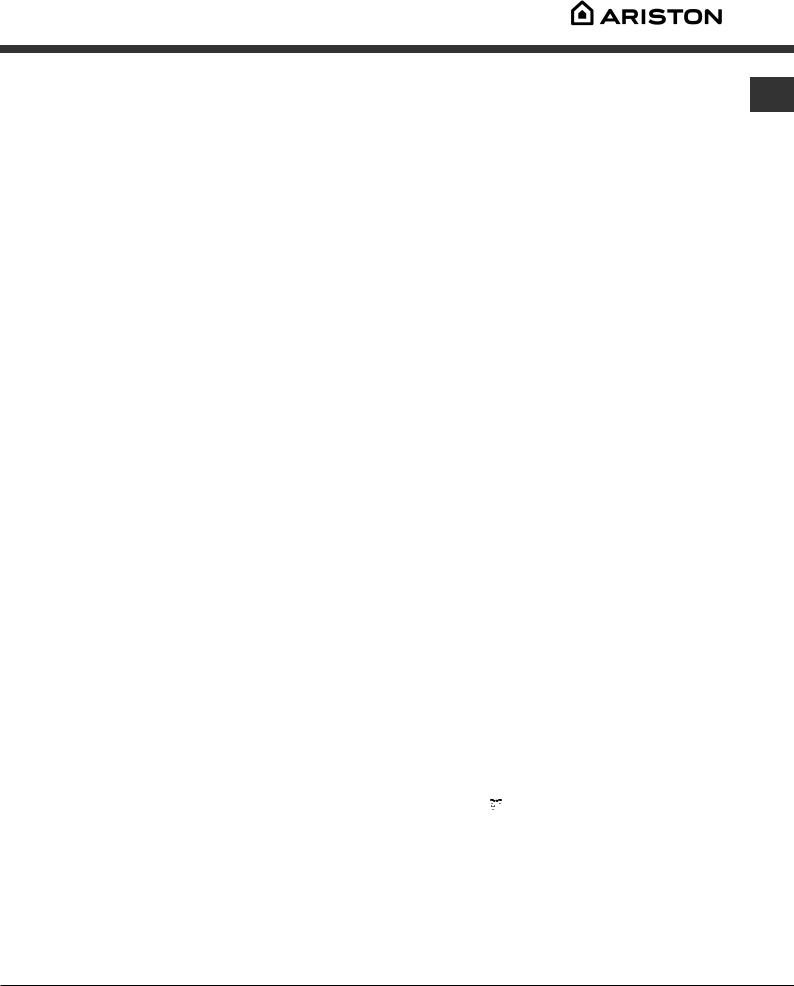
Start-up and use
!The first time you use your appliance, heat the empty oven with its door closed at its maximum temperature for at least half an hour. Ensure that the room is well ventilated before switching the oven off and opening the oven door. The appliance may emit a slightly unpleasant odour caused by protective substances used during the manufacturing process burning away.
!To make the setting process easier, keep the knob in position: this will increase the scrolling speed of the numbers on the display.
!Each setting will automatically be stored in the appliance memory after 10 seconds.
!The touch controls cannot be activated if the user is wearing gloves.
Some models are equipped with a system of hinges which allows the door to close slowly, without the user having to follow the movement through with his/ her hand. To use the system correctly, before closing the door:
•Open the door fully.
•Do not force the closing movement manually.
Control panel lock
! The control panel can be locked while the oven is off, once cooking has started or finished and during programming.
To lock the oven controls, press and hold the  button for at least 2 seconds. A buzzer sounds and the display shows the key symbol “n—O”. The
button for at least 2 seconds. A buzzer sounds and the display shows the key symbol “n—O”. The  icon, when lit, indicate lock function activation.
icon, when lit, indicate lock function activation.
To deactivate the lock, press and hold the  button again for at least 2 seconds.
button again for at least 2 seconds.
Setting the clock
! The clock can only be set when the oven is switched off. If the oven is in standby mode,
pressing the  button once will display the current time setting. Press it again to set the time.
button once will display the current time setting. Press it again to set the time.
After connection to the power supply network or after
a blackout, the  button and the digits on the display will flash for 10 seconds.
button and the digits on the display will flash for 10 seconds.
To set the clock:
1.Press button  .
.
2.Turn the TIMER knob towards “+” and “-” to adjust the hour value.
3.Once you have reached the correct hour value,
press the  button. GB 4. Repeat the above process to set the minutes.
button. GB 4. Repeat the above process to set the minutes.
If a blackout occurs, it will be necessary to reset the
clock. If the  icon flashes on the display, this indicates that the clock has not been set correctly.
icon flashes on the display, this indicates that the clock has not been set correctly.
Setting the minute minder
! The minute minder may still be set whether the oven is switched on or off. It does not switch the oven on or off.
When the set time has elapsed, the timer emits a buzzer that will automatically stop after 30 seconds or when any active button on the control panel is pressed.
To adjust the timer proceed as follows:
1.Press button  .
.
2.Adjust the time as desired by turning the TIMER knob towards “+” and “-”.
3.Once you have reached the desired value, press
the  button again.
button again.
The lit  symbol will remind you that the minute minder is on. The DISPLAY will show the countdown.
symbol will remind you that the minute minder is on. The DISPLAY will show the countdown.
To cancel the minute minder, press the  button and use the knob to set the time to 00:00. Press
button and use the knob to set the time to 00:00. Press
button  again.
again.
The  icon will switch off to indicate that the minute minder has been disabled.
icon will switch off to indicate that the minute minder has been disabled.
Starting the oven
1.Switch the control panel on by pressing the  button. The appliance buzzer sounds three times (ascending) and all buttons light up in sequence.
button. The appliance buzzer sounds three times (ascending) and all buttons light up in sequence.
2.Select the desired cooking mode by turning the SELECTOR knob. The display shows:
- the temperature associated with the mode, if programming manually;
- “Auto” and the duration alternately, if programming is automatic.
3.Press the  button to begin cooking.
button to begin cooking.
4.The oven will begin its preheating phase, the preheating indicators will light up as the temperature rises.
5.When the preheating process has finished, a buzzer sounds and all the preheating indicator lights show that this stage has been completed: the food can then be placed in the oven.
6.During cooking it is always possible to:
- modify the temperature by turning the
5
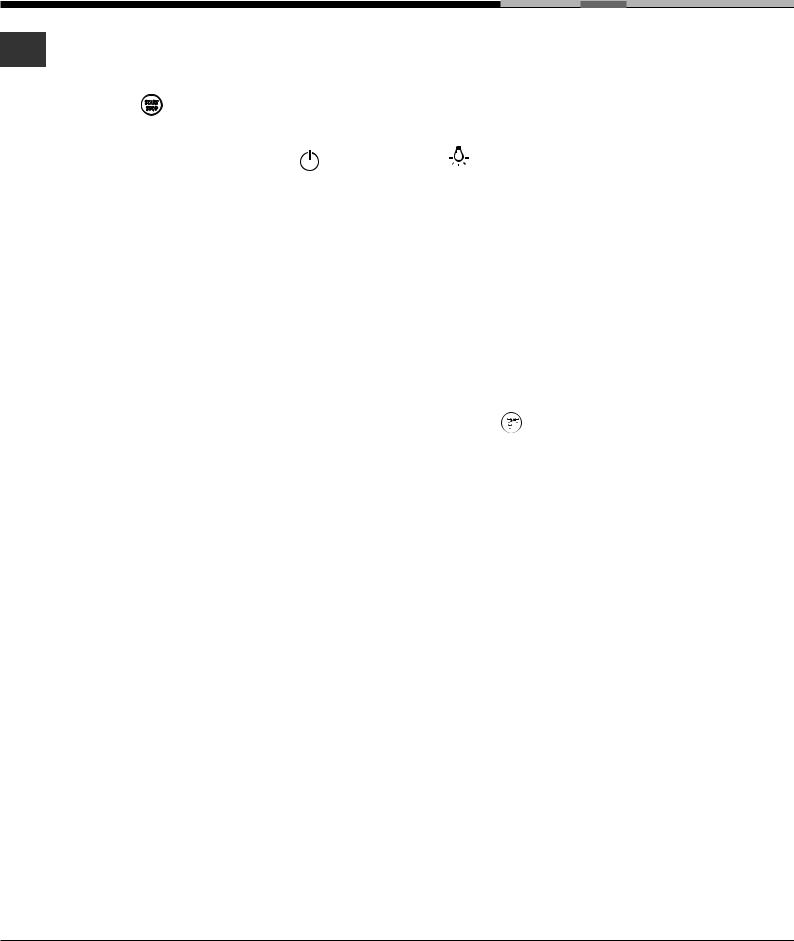
GB |
THERMOSTAT |
knob (manual modes only); |
|
|
- set the duration of a cooking mode (see Cooking |
||
|
Modes); |
|
|
|
- press the |
button to stop cooking. In this case |
|
|
the appliance stores the temperature modified |
||
|
previously in its memory (manual modes only); |
||
|
- switch off the oven by pressing the |
button for |
|
|
3 seconds. |
|
|
7. If a blackout occurs while the oven is already in operation, an automatic system within the appliance will reactivate the cooking mode from the point at which it was interrupted, provided that the temperature has not dropped below a certain level. Programmed cooking modes which have not yet started will not be restored and must be reprogrammed (for example: a cooking mode has been programmed to start at 20:30. At 19:30 a blackout occurs. When the power supply is restored, the mode will have to be reprogrammed).
!There is no preheating stage for the GRILL mode.
!Never put objects directly on the bottom of the oven; this will prevent the enamel coating from being damaged.
!Always place cookware on the rack(s) provided.
Cooling ventilation
In order to cool down the external temperature of the oven, a cooling fan blows a stream of air between the control panel and the oven door, as well as towards the bottom of the oven door.In the FAST COOKING mode, the fan is activated automatically after ten minutes.
! Once cooking has been completed, the cooling fan continues to operate until the oven has cooled down sufficiently.
Oven light
The light comes on when the oven door is opened or when a cooking mode starts.
When models featuring LED INSIDE technology begin cooking, the LEDs on the door light up for improved illumination of all cooking levels.
The button can be used to switch on the light at any time.
Residual heat indicators
The appliance is fitted with a residual heat indicator. When the oven is off, the “residual heat” bar on the display lights up to indicate high temperatures inside the oven cavity. The individual segments of the bar switch off one by one as the temperature inside the oven falls.
Restoring the factory settings
The oven factory settings can be restored to reset all selections made by the user (clock and customised durations). To carry out a reset, switch off the oven, then keep the SELECTOR knob turned while
pressing the  button for 6 seconds. Once the restore procedure is complete, a buzzer will sound.
button for 6 seconds. Once the restore procedure is complete, a buzzer will sound.
The first time the  button is pressed, the oven will behave as if it is being switched on for the first time.
button is pressed, the oven will behave as if it is being switched on for the first time.
Standby
This product complies with the requirements of the latest European Directive on the limitation of power consumption of the standby mode. If no buttons are pressed for 30 minutes and the control panel/door lock has not been activated, the appliance automatically reverts to standby mode. The standby mode is visualised by the high luminosity “Watch Icon”. As soon as interaction with the machine resumes, the system’s operating mode is restored.
6
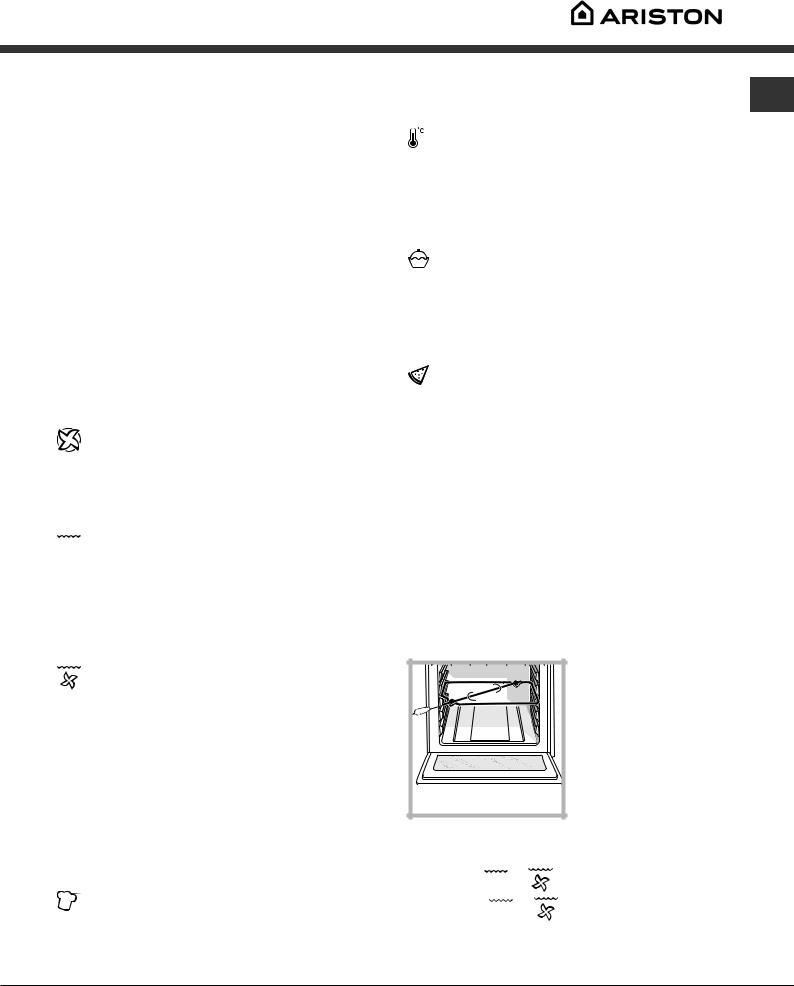
Modes
!In order to guarantee wonderfully soft and crunchy foodstuffs, the oven releases – in the form of water vapour - the humidity naturally withheld in the food itself. In this way, optimal cooking results can be achieved for all types of food.
!Every time the oven is switched on, it suggests the first manual cooking mode.
Manual cooking modes
! All cooking modes have a default cooking temperature which may be adjusted manually to a value between 30°C and 250°C as desired (300°C for GRILL mode). Any temperature adjustments will be stored in the appliance memory and suggested again the next time this mode is used. If the selected temperature is higher than the temperature inside the oven, the text “Hot” appears on the display. However, it will still be possible to start cooking.
MULTILEVEL mode
Since the heat remains constant throughout the oven, the air cooks and browns food in a uniform manner. A maximum of two racks may be used at the same time.
GRILL mode
The top heating element and the rotisserie spit (where present) are activated. The high and direct temperature of the grill is recommended for food which requires a high surface temperature. Always cook in this mode with the oven door closed (see “Practical cooking advice”).
FAN GRILLING mode
The top heating element and the rotisserie spit (where present) are activated and the fan begins to operate. During part of the cycle the circular heating element is also activated. This combination of features increases the effectiveness of the unidirectional thermal radiation provided by the heating elements through the forced circulation of the air throughout the oven.
This helps prevent food from burning on the surface and allows the heat to penetrate right into the food. Always cook in this mode with the oven door closed
(see “Practical cooking advice”).
FAST COOKING mode
This mode is particularly suitable for cooking prepacked food quickly (frozen or pre-cooked). The
best results are achieved using one cooking rack
only. |
GB |
|
|
LOW TEMPERATURE modes |
|
This type of cooking can be used for proving, |
|
defrosting, preparing yoghurt, heating dishes at the |
|
required speed and slow cooking at low |
|
temperatures. The temperature options are: 40, 65 |
|
and 90°C. |
|
BAKING mode |
|
The rear heating element and the fan are switched |
|
on, thus guaranteeing the distribution of heat in a |
|
delicate and uniform manner throughout the entire |
|
oven. This mode is ideal for baking temperature |
|
sensitive foods (such as cakes, which need to rise). |
|
PIZZA mode |
|
The top and circular heating elements switch on and |
|
the fan begins to operate. This combination heats |
|
the oven rapidly. If you use more than one rack at a |
|
time, switch the position of the dishes halfway |
|
through the cooking process. |
|
ECO mode
The rear heating element and the fan are switched on, thus guaranteeing the distribution of heat in a delicate
and uniform manner throughout the entire oven.This energy saving mode is recommended for small dishes, ideal for heating foods and finishing off cooking.
Rotisserie (only available in certain models)
To operate the
rotisserie function (see
diagram) proceed as
follows:
1. Place the dripping pan in position 1.
2. Place the rotisserie
support in position 3 and insert the spit in the hole provided on the back panel of the
oven.
3. Start the rotisserie using the SELECTOR knob to
select mode |
or |
. |
When modes |
or |
are activated, the |
rotisserie will stop if the door is opened.
7

Automatic cooking modes
GB
!The temperature and the cooking duration are pre-set values, guaranteeing a perfect result every time - automatically. These values are set using the
C.O.P.® (Programmed Optimal Cooking) system. The cooking cycle stops automatically and the oven indicates when the dish is cooked. You may start cooking whether the oven has been preheated or not. The cooking duration can be customised according to personal taste by modifying the relevant value - before cooking begins - by ±5/20 minutes depending on the selected programme. The duration can however be modified even once cooking has begun. If the value is modified before the programme begins, it is stored in the memory and suggested again by the appliance when the programme is next used. If the temperature inside the oven is higher than the suggested value for the selected mode, the text “Hot” appears on the display and it will not be possible to begin cooking; wait for the oven to cool.
!When the cooking stage has been reached, the oven buzzer sounds.
!Do not open the oven door as this will disrupt the cooking time and temperature.
BAKED CAKES mode
This function is ideal for cooking desserts which are made using natural yeast, baking powder and desserts which contain no yeast. Place the dish in the oven while it is still cold. The dish may also be placed in a preheated oven.
BREAD mode
Use this function to bake bread. To obtain the best results, we recommend that you carefully observe the instructions below:
•follow the recipe;
•do not exceed the maximum weight of the dripping pan;
•remember to pour 50 g (0,5 dl) of cold water into the baking tray in position 5.
•The dough must be left to rise at room temperature for 1 – 1 ½ hours (depending on the room temperature) or until the dough has doubled in size.
Recipe for BREAD:
1 Dripping pan holding 1000 g Max, lower level
2 Dripping pans each holding 1000 g Max, medium and lower levels
Recipe for 1000 g of dough: 600 g flour, 360 g water, 11g salt, 25 g fresh yeast (or 2 sachets of powder yeast)
Method:
•Mix the flour and salt in a large bowl.
•Dilute the yeast in lukewarm water (approximately 35 degrees).
•Make a small well in the mound of flour.
•Pour in the water and yeast mixture.
•Knead the dough by stretching and folding it over itself with the palm of your hand for 10 minutes until it has a uniform consistency and is not too sticky.
•Form the dough into a ball shape, place it in a large bowl and cover it with transparent plastic wrap to prevent the surface of the dough from drying out. Select the manual LOW TEMPERATURE function on the oven and set the temperature to 40°C. Place the bowl inside and leave the dough to rise for approximately 1 hour (the dough should double in volume).
•Cut the dough into equal sized loaves.
•Place them in the dripping pan, on a sheet of baking paper.
•Dust the loaves with flour.
•Make incisions on the loaves.
•Place the food inside the oven while it is still cold.
• Start the |
BREAD cooking mode. |
•Once baked, leave the loaves on one of the grill racks until they have cooled completely.
8
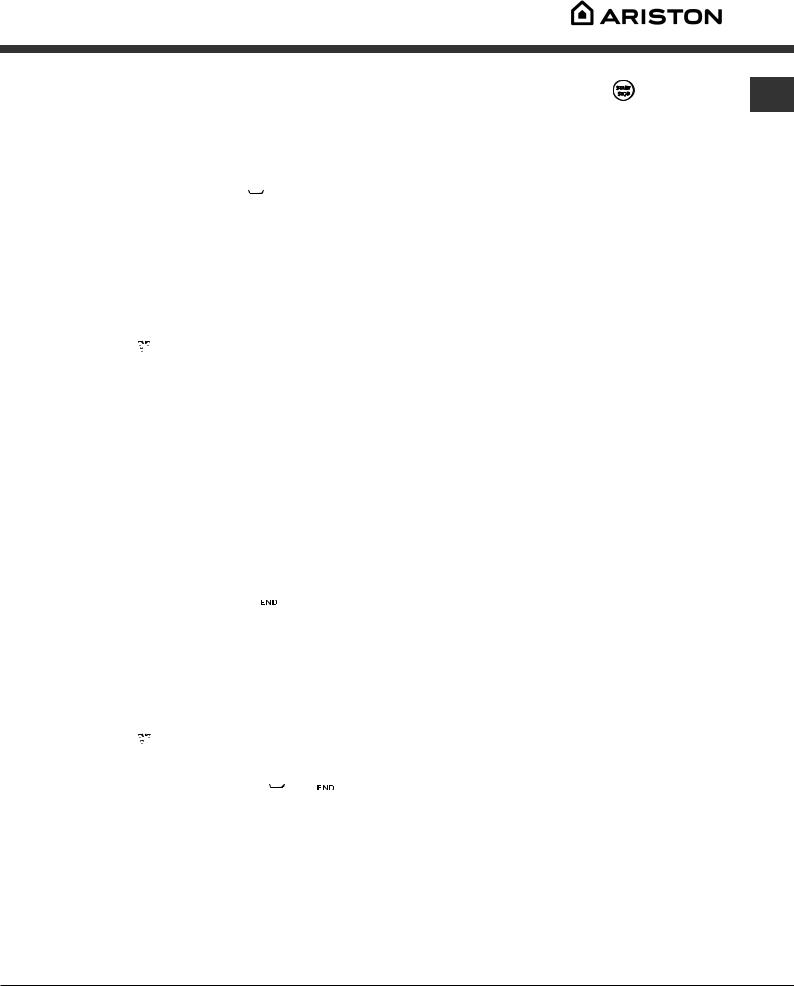
Programming cooking
! A cooking mode must be selected before programming can take place.
Programming the cooking duration
1.Press the  button until the
button until the  icon and the numerical digits on the display begin to flash.
icon and the numerical digits on the display begin to flash.
2.Turn the TIMER knob towards “+” and “-” to adjust the time as desired; keep the knob in position to scroll through the numbers more quickly and make the setting process easier.
3.Once you have reached the desired duration,
press the  button again. The display will show the duration and set temperature alternately.
button again. The display will show the duration and set temperature alternately.
4.Press the  button to begin cooking.
button to begin cooking.
5.When cooking has finished, “END” appears on the display and a buzzer sounds.
• For example: it is 9:00 a.m. and a duration of 1 hour and 15 minutes is programmed. The programme will stop automatically at 10:15 a.m.
Setting the end time for a cooking mode
!A cooking duration must be set before the cooking end time can be scheduled.
!For the delayed programming to work properly, the clock should be set to the correct time.
1.Follow steps 1 to 3 to set the duration as detailed above.
2.Press the  button twice: the
button twice: the  icon and the numerical digits on the display will begin to flash.
icon and the numerical digits on the display will begin to flash.
3.Turn the TIMER knob towards “+” and “-” to adjust the cooking end time value.
4.Once you have reached the desired end time,
press the  button again. The display will show the duration, the cooking end time and the set temperature alternately.
button again. The display will show the duration, the cooking end time and the set temperature alternately.
5. Press the  button to activate the programmed mode.
button to activate the programmed mode.
Programming has been set when the  and
and buttons are illuminated. The DISPLAY shows the cooking end time and the cooking duration alternately.
buttons are illuminated. The DISPLAY shows the cooking end time and the cooking duration alternately.
6. Once cooking has finished, “END” appears on the display and a buzzer sounds.
•For example: it is 9:00 a.m. and a time of 1 hour and 15 minutes is programmed, while the end time is set to 12:30. The programme will start automatically at 11:15 a.m.
To cancel programming press the |
button. |
GB |
Practical cooking advice
!Do not place racks in position 1 and 5 during fanassisted cooking. This is because excessive direct heat can burn temperature sensitive foods.
!In the GRILL and FAN GRILLING cooking modes, particularly when using the rotisserie spit, place the dripping pan in position 1 to collect cooking residues (fat and/or grease).
MULTILEVEL
•Use positions 2 and 4, placing the food which requires more heat on 2.
•Place the dripping pan on the bottom and the rack on top.
BARBECUE
•Place the rack in position 3 or 4. Position the food in the centre of the rack.
•We recommend that the power level is set to maximum. The top heating element is regulated by a thermostat and may not always operate constantly.
PIZZA OVEN
•Use a lightweight aluminium pizza pan. Place it on the rack provided.
For a crispy crust, do not use the dripping pan as this extends the total cooking duration and prevents the crust from forming.
•If the pizza has a lot of toppings, we recommend adding the mozzarella cheese to the top of the pizza halfway through the cooking process.
9

Cooking advice table
GB |
|
|
|
|
|
|
|
|
|
|
|
|
Modes |
Foods |
Weight |
Rack position |
Preheating |
Recommended |
Cooking |
||||
|
|
|
|||||||||
|
|
|
|
|
(Kg) |
|
|
|
|
Temperature |
duration |
|
|
|
|
|
|
|
|
|
|
(°C) |
(minutes) |
|
|
|
|
|
|
standard |
|
sliding |
|
|
|
|
|
|
|
Manual |
|
|
|
|
|
||
|
|
|
|
|
guide rails |
|
guide rails |
|
|
|
|
|
|
|
|
|
|
|
|
|
|
||
|
|
|
Multilevel* |
Pizza on 2 racks |
|
2 and 4 |
|
1 and 3 |
yes |
210-220 |
20-25 |
|
|
|
|
Pies on two racks/cakes on 2 racks |
|
2 and 4 |
|
1 and 3 |
yes |
180 |
30-35 |
|
|
|
|
Sponge cake on 2 racks (on the dripping pan) |
|
2 and 4 |
|
1 and 3 |
yes |
160-170 |
20-25 |
|
|
|
|
Roast chicken + potatoes |
1+1 |
1 and 2/3 |
|
1 and 3 |
yes |
200-210 |
65-75 |
|
|
|
|
Lamb |
1 |
2 |
|
1 |
yes |
190-200 |
45-50 |
|
|
|
|
Mackerel |
1 |
1 or 2 |
|
1 |
yes |
180 |
30-35 |
|
|
|
|
Lasagne |
1 |
2 |
|
1 |
yes |
180-190 |
35-40 |
|
|
|
|
Cream puffs on 3 racks |
|
1 and 3 and 5 |
|
1 and 2 and 4 |
yes |
190 |
20-25 |
|
|
|
|
Biscuits on 3 racks |
|
1 and 3 and 5 |
|
1 and 2 and 4 |
yes |
180 |
10-20 |
|
|
|
|
Cheese puffs on 2 racks |
|
2 and 4 |
|
1 and 3 |
yes |
210 |
20-25 |
|
|
|
|
Savoury pies |
|
1 and 3 |
|
1 and 3 |
yes |
190-200 |
20-30 |
|
|
|
Grill* |
Mackerel |
1 |
4 |
|
3 |
no |
300 |
15-20 |
|
|
|
|
Sole and cuttlefish |
0,7 |
4 |
|
3 |
no |
300 |
10-15 |
|
|
|
|
Squid and prawn kebabs |
0,7 |
4 |
|
3 |
no |
300 |
8-10 |
|
|
|
|
Cod fillet |
0,7 |
4 |
|
3 |
no |
300 |
10-15 |
|
|
|
|
Grilled vegetables |
0,5 |
3 or 4 |
|
2 or 3 |
no |
300 |
15-20 |
|
|
|
|
Veal steak |
0,8 |
4 |
|
3 |
no |
300 |
15-20 |
|
|
|
|
Sausages |
0,7 |
4 |
|
3 |
no |
300 |
15-20 |
|
|
|
|
Hamburgers |
n° 4 or 5 |
4 |
|
3 |
no |
300 |
10-12 |
|
|
|
|
Toasted sandwiches (or toast) |
n° 4 or 6 |
4 |
|
3 |
no |
300 |
3-5 |
|
|
|
|
Spit-roast chicken using rotisserie spit (where present) |
1 |
- |
|
- |
no |
300 |
70-80 |
|
|
|
|
Spit-roast lamb using rotisserie spit (where present) |
1 |
- |
|
- |
no |
300 |
70-80 |
|
|
|
Fan grilling* |
Grilled chicken |
1,5 |
2 |
|
2 |
no |
210 |
55-60 |
|
|
|
|
Cuttlefish |
1 |
2 |
|
2 |
no |
200 |
30-35 |
|
|
|
|
Spit-roast chicken using rotisserie spit (where present) |
1,5 |
- |
|
- |
no |
210 |
70-80 |
|
|
|
|
Spit-roast duck using rotisserie spit (where present) |
1,5 |
- |
|
- |
no |
210 |
60-70 |
|
|
|
|
Roast veal or beef |
1 |
2 |
|
2 |
no |
210 |
60-75 |
|
|
|
|
Roast pork |
1 |
2 |
|
2 |
no |
210 |
70-80 |
|
|
|
|
Lamb |
1 |
2 |
|
2 |
no |
210 |
40-45 |
|
|
|
Fast cooking* |
Frozen food |
|
|
|
|
|
|
|
|
|
|
|
Pizza |
0.3 |
2 |
|
1 |
- |
250 |
12 |
|
|
|
|
Courgette and prawn pie |
0.4 |
2 |
|
1 |
- |
200 |
20 |
|
|
|
|
Country style spinach pie |
0.5 |
2 |
|
1 |
- |
220 |
30-35 |
|
|
|
|
Turnovers |
0.3 |
2 |
|
1 |
- |
200 |
25 |
|
|
|
|
Lasagne |
0.5 |
2 |
|
1 |
- |
200 |
35 |
|
|
|
|
Golden rolls |
0.4 |
2 |
|
1 |
- |
180 |
25-30 |
|
|
|
|
Chicken bites |
0.4 |
2 |
|
1 |
- |
220 |
15-20 |
|
|
|
|
|
|
|
|
|
|
|
|
|
|
|
|
Pre-cooked food |
|
|
|
|
|
|
|
|
|
|
|
Golden chicken wings |
0.4 |
2 |
|
1 |
- |
200 |
20-25 |
|
|
|
|
|
|
|
|
|
|
|
|
|
|
|
|
Fresh Food |
|
|
|
|
|
|
|
|
|
|
|
Biscuits (shortcrust pastry) |
0.3 |
2 |
|
1 |
- |
200 |
15-18 |
|
|
|
|
Sponge cake made with yoghurt |
0.6 |
2 |
|
1 |
- |
180 |
45 |
|
|
|
|
Cheese puffs |
0.2 |
2 |
|
1 |
- |
210 |
10-12 |
|
|
|
|
|
|
|
|
|
|
|
|
|
|
|
Low |
Duck |
1,5 |
2 |
|
1 |
yes |
200-210 |
70-80 |
|
|
|
temperature* |
Chicken |
1,5 |
2 |
|
1 |
yes |
200-210 |
60-70 |
|
|
|
|
Roast veal or beef |
1 |
2 |
|
1 |
yes |
200 |
70-75 |
|
|
|
|
Roast pork |
1 |
2 |
|
1 |
yes |
200-210 |
70-80 |
|
|
|
|
Biscuits (shortcrust pastry) |
- |
2 |
|
1 |
yes |
180 |
15-20 |
|
|
|
|
Tarts |
1 |
2 |
|
1 |
yes |
180 |
30-35 |
|
|
|
|
|
|
|
|
|
|
|
|
|
|
|
Baking* |
Tarts |
0,5 |
2 or 3 |
|
1 or 2 |
yes |
180 |
25-35 |
|
|
|
|
Fruit cakes |
1 |
2 or 3 |
|
1 or 2 |
yes |
180 |
40-50 |
|
|
|
|
Sponge cake made with yoghurt |
0,7 |
2 or 3 |
|
1 or 2 |
yes |
170-180 |
45-55 |
|
|
|
|
Small cakes on 2 racks |
0,7 |
2 and 4 |
|
1 and 3 |
yes |
180-190 |
20-25 |
|
|
|
|
Sponge cake |
0,6 |
2 or 3 |
|
1 or 2 |
yes |
160-170 |
30-40 |
|
|
|
|
Cream puffs on 3 racks |
0,7 |
1, 3 and 5 |
|
1, 2 and 4 |
yes |
180-190 |
20-25 |
|
|
|
|
Biscuits on 3 racks |
0,7 |
1, 3 and 5 |
|
1, 2 and 4 |
yes |
180 |
20-25 |
|
|
|
|
Filled pancakes |
0,8 |
2 |
|
1 |
yes |
200 |
30-35 |
|
|
|
|
Meringues on 3 racks |
0,5 |
1, 3 and 5 |
|
1, 2 and 4 |
yes |
90 |
180 |
|
|
|
|
Cheese puffs |
0,5 |
2 |
|
1 |
yes |
210 |
20-25 |
|
|
|
Pizza* |
Pizza |
0,5 |
2 |
|
1 |
yes |
210-220 |
15-20 |
|
|
|
|
Focaccia bread |
0,5 |
2 |
|
1 |
yes |
190-200 |
20-25 |
|
|
|
|
|
|
|
|
|
|
|
|
|
|
|
|
Automatic** |
|
|
|
|
|
|
|
|
|
|
Baked cakes |
Baked cakes |
1 |
2 or 3 |
2 |
no |
|
|
|
|
|
|
|
|
|
|
|
|
|
|
|
|
|
|
Bread*** |
Bread (see recipe) |
1 |
1 or 2 |
1 |
no |
|
|
|
|
|
|
|
|
|
|
|
|
|
|
|
*The cooking times listed above are intended as guidelines only and may be modified according to personal tastes. Oven preheating times are set as standard and may not be modified manually.
**The duration of the automatic cooking functions are set by default. The values can be modified by the user, starting with the default duration.
***As stated in the recipe, pour 50 g (0,5 dl) water into the dripping pan in position 5.
! ECO programme: This programme – which has longer cooking times but guarantees sensible energy saving – is recommended for dishes such as fish fillets, small pastries and vegetables. It is also suitable for warming foodstuffs and for completing cooking.
10

Precautions and tips
! This appliance has been designed and manufactured in compliance with international safety standards. The following warnings are provided for safety reasons and must be read carefully.
General safety
•The appliance was designed for domestic use inside the home and is not intended for commercial or industrial use.
•The appliance must not be installed outdoors, even in covered areas. It is extremely dangerous to leave the appliance exposed to rain and storms.
•When moving or positioning the appliance, always use the handles provided on the sides of the oven.
•Do not touch the appliance while barefoot or with wet or damp hands and feet.
•The appliance must be used by adults only for the preparation of food, in accordance with the instructions provided in this booklet. Any other use of the appliance (e.g. for heating the room) constitutes improper use and is dangerous.
The manufacturer may not be held responsible for any damage caused as a result of improper, incorrect and unreasonable use of the appliance.
•Do not touch the heating elements or certain parts of the oven door when the appliance is in use; these parts become extremely hot. Keep children well away from the appliance.
•Make sure that the power supply cables of other electrical appliances do not come into contact with the hot parts of the oven.
•The ventilation and heat dispersal openings must never be obstructed.
•Always grip the oven door handle in the centre: the ends may be hot.
•Always use oven gloves when placing cookware in the oven or when removing it.
•Do not use aluminium foil to line the bottom of the oven.
•Do not place flammable materials in the oven: if the appliance is switched on accidentally, the materials could catch fire.
•Always make sure the knobs are in the “ ”/“ ” position when the appliance is not in use.
•When unplugging the appliance, always pull the plug from the mains socket; do not pull on the cable.
•Do not perform any cleaning or maintenance work without having disconnected the appliance from the electricity mains.
•If the event of malfunctions, under no circumstances should you attempt to perform the repairs yourself. Contact an authorised Service Centre (see Assistance).
• |
Do not rest objects on the open oven door. |
GB |
|
• |
The appliance should not be operated by people |
||
|
|||
|
(including children) with reduced physical, |
|
|
|
|
||
|
sensory or mental capacities, by inexperienced |
|
|
|
individuals or by anyone who is not familiar with |
|
|
|
the product. These individuals should, at the very |
|
|
|
least, be supervised by someone who assumes |
|
|
|
responsibility for their safety or receive |
|
|
|
preliminary instructions relating to the operation of |
|
|
|
the appliance. |
|
|
• |
Do not let children play with the appliance. |
|
Disposal
•When disposing of packaging material: observe local legislation so that the packaging may be reused.
•The European Directive 2002/96/EC relating to Waste Electrical and Electronic Equipment (WEEE) states that household appliances should not be disposed of using the normal solid urban waste cycle. Exhausted appliances should be collected separately in order to optimise the cost of re-using and recycling the materials inside the machine, while preventing potential damage to the atmosphere and to public health. The crossed-out dustbin is marked on all products to remind the owner of their obligations regarding separated waste collection.
For further information relating to the correct disposal of exhausted household appliances, owners may contact the relevant public service or their local dealer.
Respecting and conserving the environment
•You can help to reduce the peak load of the electricity supply network companies by using the oven in the hours between late afternoon and the early hours of the morning. The cooking mode programming options, the “delayed cooking” mode (see Cooking modes) and “delayed automatic cleaning” mode (see Care and Maintenance) in particular, enable the user to organise their time efficiently.
•Always keep the oven door closed when using the GRILL and FAN GRILLING modes: this will achieve improved results while saving energy (approximately 10%).
•Check the door seals regularly and wipe them clean to ensure they are free of debris so that they adhere properly to the door, thus avoiding
the dispersal of heat.
! This product complies with the requirements of the latest European Directive on the limitation of power consumption of the standby mode.
11

Care and maintenance
Switching the appliance off
GB
Disconnect your appliance from the electricity supply before carrying out any work on it.
Cleaning the appliance
•Slight differences in colour on the front of the oven are due to the different materials used, i.e. glass, plastic or metal.
•Any shady areas resembling grooves on the oven door glass are caused by reflections from the oven light.
•The enamel is branded at very high temperatures. This process may cause colour variations. This is normal and will not affect appliance operation in any way. The thin edges of the sheet metal cannot be entirely enamelled and may therefore appear to be unfinished. This will not affect the rust protection.
•The stainless steel or enamel-coated external parts and the rubber seals may be cleaned using a sponge that has been soaked in lukewarm water and neutral soap. Use specialised products for the removal of stubborn stains. After cleaning, rinse and dry thoroughly. Do not use abrasive powders or corrosive substances.
•The inside of the oven should ideally be cleaned after each use, while it is still lukewarm. Use hot water and detergent, then rinse well and dry with a soft cloth. Do not use abrasive products.
•All accessories - with the exception of the sliding racks - can be washed like everyday crockery, and are even dishwasher safe.
•We recommend that detergents are not sprayed directly onto the control panel, but that a sponge
is used instead.
! Never use steam cleaners or pressure cleaners on the appliance.
Cleaning the oven door
! The door of LED INSIDE models cannot be removed.
Clean the glass part of the oven door using a sponge and a non-abrasive cleaning product, then dry thoroughly with a soft cloth. Do not use rough abrasive material or sharp metal scrapers as these could scratch the surface and cause the glass to crack.
For more thorough cleaning purposes, the oven door may be removed:
1.Open the oven door fully (see diagram).
2.Use a screwdriver to lift up and turn the small levers F located on the two hinges (see diagram).
F |
3. Grip the door on the two outer sides and close it approximately half way. Pull the door towards you, lifting it out of its slot (see diagram). To replace the door, reverse this sequence.
Inspecting the seals
Check the door seals around the oven regularly. If the seals are damaged, please contact your nearest Service Centre (see Assistance). We recommend that the oven is not used until the seals have been replaced.
Replacing the light bulb |
|
|
To replace the |
Lamp Holder |
oven light bulb: |
compartment |
1. Remove the |
|
|
|
glass cover of the |
Lamp |
lamp-holder. |
|
|
|
2. Remove the |
|
light bulb and |
Glass cover |
replace it with a |
|
|
|
similar one: |
|
halogen lamp |
|
voltage 230 V, |
wattage 25 W, cap G 9.
3. Replace the glass cover (see diagram).
! Do not touch the light bulb directly with your hands.
Sliding rack kit assembly
A |
To assemble the sliding racks:
1. Remove the two frames, lifting them away from the spacers A (see figure).
12
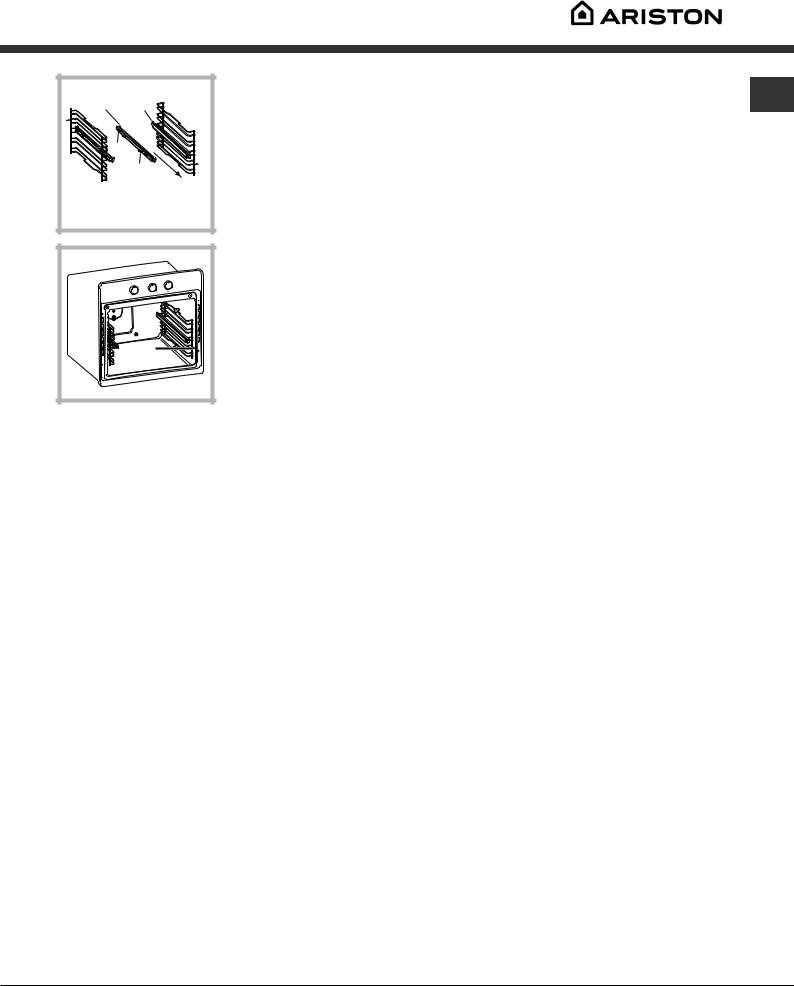
Left |
Right guide |
|
guide rail |
rail |
|
B |
|
|
|
C |
|
|
of |
|
|
|
Direction |
|
|
extraction |
D |
2.Choose which shelf to use with the sliding rack. Paying attention to the direction in which the sliding rack is to be extracted, position joint B and then joint C on the frame.
3.Secure the two frames with the guide rails using the holes provided on the oven walls (see diagram). The holes for the left frame are situated at the top, while the holes for the right frame are at the bottom.
4. Finally, fit the frames on the spacers A.
! Do not place the sliding racks in position 5.
GB
13

Troubleshooting
GB |
|
Problem |
Possible cause |
Solution |
|
|
The “Clock button” and the |
The appliance has just been |
Set the clock. |
|
||||
|
|
digits on the display flash. |
connected to the electricity |
|
|
|
|
mains or there has been a blackou |
|
|
|
A programmed cooking mode |
There has been a blackout. |
Reprogram the cooking mode. |
|
|
does not start. |
|
|
|
|
Only the high luminosity |
The appliance is in standby mode |
Press any button to exit |
|
|
“Clock button” is lit. |
|
standby mode. |
|
|
An automatic mode has been |
The temperature inside the oven |
Wait for the oven to cool down. |
|
|
selected. “Hot” appears on the |
is higher than the suggested value |
|
|
|
display and cooking does not start |
for the selected mode. |
|
|
|
Fan-assisted cooking has been |
Positions 1 and 5: the direct |
We recommend switching |
|
|
selected and the food looks burnt. |
heat could cause |
dripping pan positions halfway |
|
|
|
temperature-sensitive |
through cooking. |
|
|
|
foods to burn. |
|
|
|
|
|
|
14
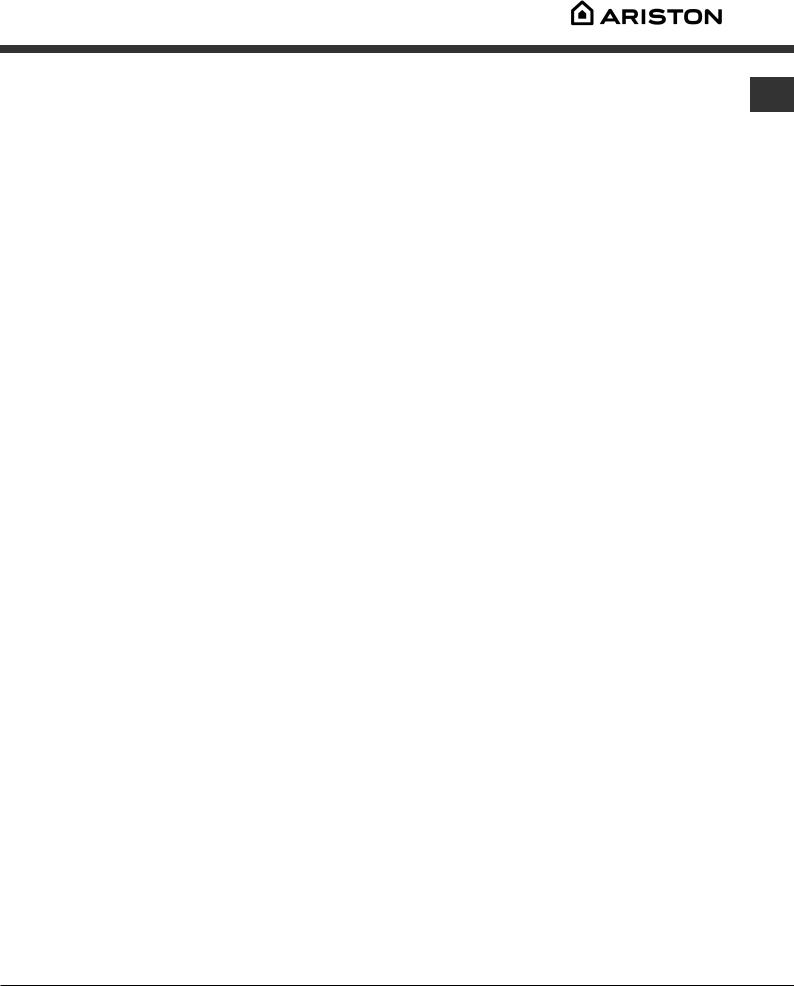
Assistance
Warning:
The appliance is fitted with an automatic diagnostic system which detects any malfunctions. Malfunctions are GB signalled through messages of the following type: “F”, followed by numbers.
Call for technical assistance in the event of a malfunction.
Before calling for Assistance:
•Check whether you can fix the problem yourself.
•Restart the programme to check whether the malfunction has disappeared.
•If it has not, contact the Authorised Technical Assistance Service.
! Never use the services of an unauthorised technician.
Please have the following information to hand:
•The type of problem encountered.
•The message displayed.
•The appliance model (Mod.).
•The serial number (S/N).
The latter two pieces of information can be found on the data plate located on the appliance.
15
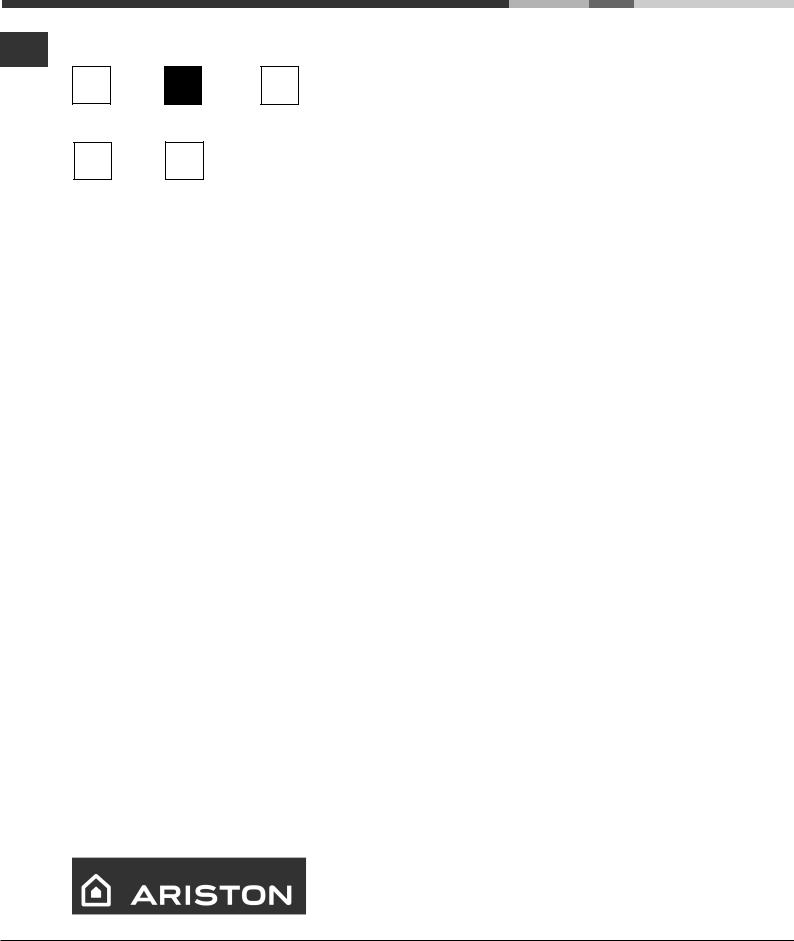
Mode d’emploi
FR
GB FR ES
English,1 |
Français, 16 Espanol, 31 |
PT AR
Portuges, 46
FK 89E X
FK 996ESC X
FK 89E
FK 996ESC
FK 996E C X
FOUR
Sommaire
Installation, 17-18
Positionnement
Raccordement électrique
Caractéristiques techniques
Description de l’appareil, 19
Vue d’ensemble
Tableau de bord
Afficheur
Mise en marche et utilisation, 20-21
Verrouillage de commandes Régler l’horloge
Régler le minuteur Mise en marche du four
Rétablissement des réglages d’usine Standby
Programmes, 22-25
Programmes de cuisson manuels
Programmes de cuisson automatiques
Comment programmer une cuisson
Conseils de cuisson
Tableau de cuisson
Précautions et conseils, 26
Sécurité générale
Mise au rebut
Economie et respect de l’environnement
Nettoyage et entretien, 27-28
Mise hors tension
Nettoyage de l’appareil
Nettoyage de la porte
Remplacement de l’ampoule d’éclairage
Montage du Kit glissières coulissantes
Anomalies et remèdes, 29
Assistance, 30
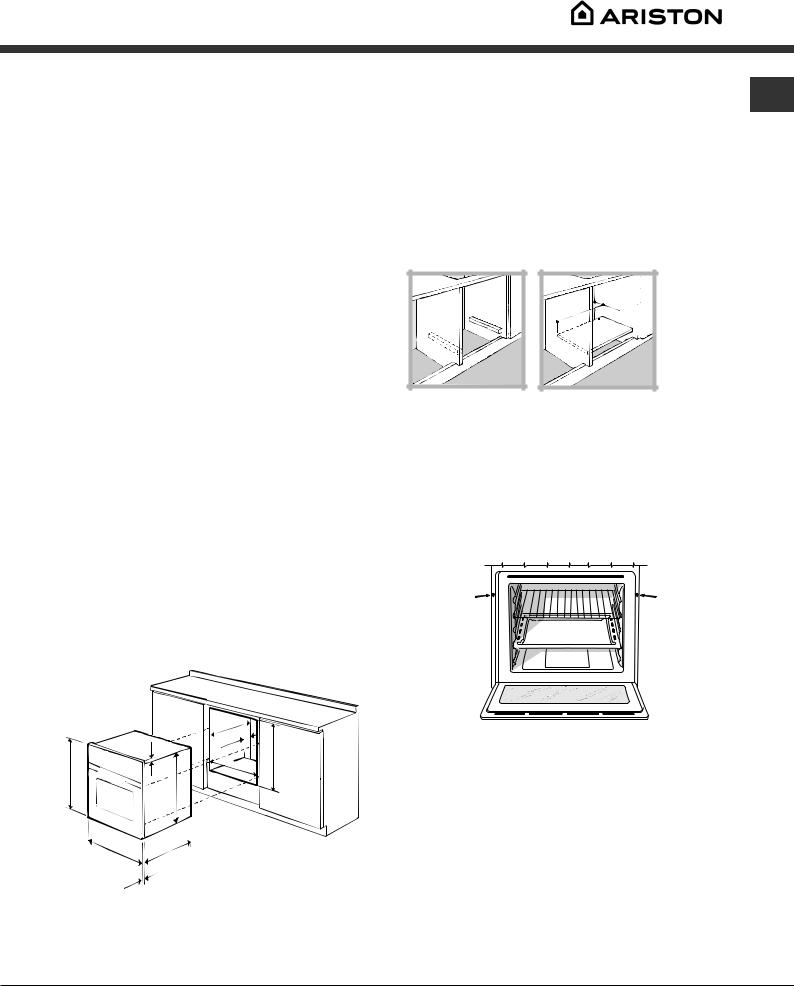
Installation
!Important : conserver ce mode d’emploi pour pouvoir le consulter à tout moment. En cas de vente, de cession ou de déménagement, veiller à ce qu’il suive l’appareil pour informer le nouveau propriétaire sur son fonctionnement et lui fournir les conseils correspondants.
! Lire attentivement les instructions : elles contiennent des conseils importants sur l’installation, l’utilisation et la sécurité de cet appareil.
Positionnement
!Les emballages ne sont pas des jouets pour enfants, il faut les mettre au rebut en respectant la réglementation sur le tri sélectif des déchets (voir Précautions et conseils).
!L’installation doit être effectuée par un professionnel du secteur conformément aux instructions du fabricant. Une mauvaise installation peut causer des dommages à des personnes, des animaux ou des biens.
Encastrement
Pour garantir le bon fonctionnement de l’appareil, il faut que le meuble possède des caractéristiques bien précises :
•les panneaux adjacents doivent être fabriqués dans un matériau résistant à la chaleur ;
•dans le cas de meubles en plaqués bois, les colles doivent pouvoir résister à une température de 100 °C ;
•la cavité du meuble pour encastrement du four, tant sous plan (voir figure) qu’en colonne, doit avoir les dimensions suivantes :
Les déclarations de consommation indiquées sur
l’étiquette des caractéristiques ont été mesurées FR pour ce type d’installation
Aération
Afin de garantir une bonne aération, la cavité d’encastrement doit être dépourvue de paroi arrière. Il est conseillé d’installer le four de manière à ce qu’il repose sur deux cales en bois ou bien sur un plan d’appui continu qui ait une découpe d’au moins 45 x 560 mm (voir figures).
. |
45 |
mm |
. |
mm |
|
||
560 |
|
|
|
Centrage et fixation
Pour fixer l’appareil au meuble :
•ouvrir la porte du four;
•Retirer les 2 caoutchouc qui couvrent les trous de fixation situés sur le cadre;
•Fixer le four au meuble en utilisant 2 vis à bois
•Repositionner les caoutchouc couvre-trous.
|
|
|
. |
|
|
|
mm |
mm.590 |
20mm. |
mm.570 |
550 . |
585-575mm. |
|||
|
|
|
min |
|
|
|
. |
|
|
|
mm |
|
|
|
45 |
560 |
mm. |
|
595 |
mm. |
|
. |
|
mm |
||
|
|
550 |
. |
|
|
mm |
|
|
|
|
.* |
|
|
20,5 mm |
|
|
|
22,5 |
|
* Seulement pour modèles inox
! Après encastrement de l’appareil, il ne doit plus y avoir possibilité de contact avec les parties électrifiées.
! Toutes les parties qui servent de protection doivent être fixées de manière à ne pouvoir être enlevées qu’avec l’aide d’un outil.
17
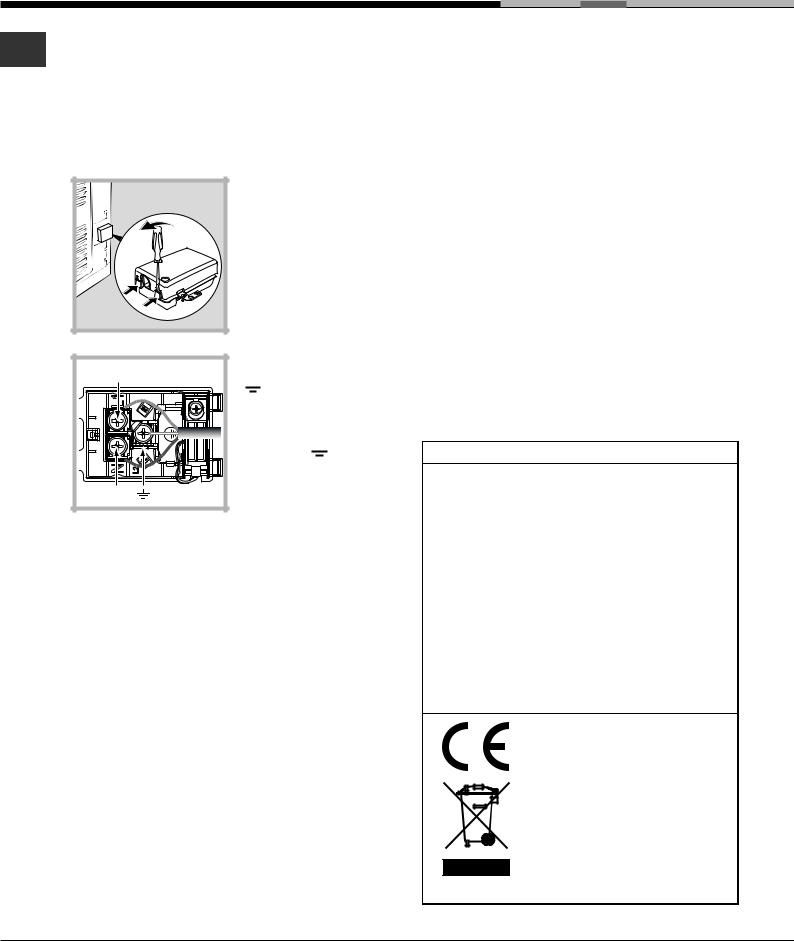
Raccordement électrique
FR
! Les fours munis d’un câble d’alimentation tripolaire sont prévus pour un fonctionnement au courant alternatif à la tension et à la fréquence indiquées sur la plaque signalétique apposée sur l’appareil (voir ci-dessous).
Montage du câble d’alimentation
L |
N
1.Pour ouvrir le bornier, faire pression à l’aide d’un tournevis sur les languettes latérales du couvercle : tirer et ouvrir le couvercle (voir figure).
2.Montage du câble d’alimentation : dévisser la vis du serrecâble ainsi que les trois vis des contacts L-N-  puis fixer les fils sous les têtes de vis en respectant les couleurs Bleu (N) Marron (L) Jaune-Vert
puis fixer les fils sous les têtes de vis en respectant les couleurs Bleu (N) Marron (L) Jaune-Vert  (voir figure).
(voir figure).
3.Fixer le câble dans le serre-câble prévu.
4.Fermer le couvercle du bornier.
Branchement du câble d’alimentation au réseau électrique
Monter sur le câble une prise normalisée pour la charge indiquée sur l’étiquette des caractéristiques (voir ci-contre).
En cas de raccordement direct au réseau, il faut intercaler entre l’appareil et le réseau un interrupteur à coupure omnipolaire ayant au moins 3 mm d’écartement entre les contacts, dimensionné à la charge et conforme aux normes en vigueur (le fil de terre ne doit pas être interrompu par l’interrupteur). Le câble d’alimentation ne doit atteindre, en aucun point, une température dépassant de 50°C la température ambiante (celle par exemple du panneau arrière du four).
! L’installateur est responsable du bon raccordement électrique de l’appareil et du respect des normes de sécurité.
Avant de procéder au branchement, s’assurer que :
• la prise est bien munie d’une terre conforme à la loi ;
•la prise est bien apte à supporter la puissance maximale de l’appareil, indiquée sur la plaque signalétique (voir ci-dessous) ;
•la tension d’alimentation est bien comprise entre les valeurs indiquées sur la plaque signalétique (voir ci-dessous) ;
•la prise est bien compatible avec la fiche de l’appareil. Si ce n’est pas le cas, remplacer la prise ou la fiche, ne pas utiliser de rallonges ni de prises multiples.
!Après installation de l’appareil, le câble électrique et la prise de courant doivent être facilement accessibles.
!Le câble ne doit être ni plié ni excessivement écrasé.
!Il doit être contrôlé périodiquement et ne peut être remplacé que par un technicien agréé (voir Assistance).
!Nous déclinons toute responsabilité en cas de non respect des normes énumérées ci-dessus.
PLAQUE SIGNALETIQUE
Dimensions |
largeur 43,5 cm |
hauteur 32 cm |
|
|
profondeur 41,5cm |
|
|
Volume |
L. 58 |
|
|
Raccordements |
tension 220-240V~ 50/60Hz |
(voir plaque signalétique) |
|
électriques |
puissance maximum absorbée |
|
2800W |
|
|
|
Directive 2002/40/CE sur l'étiquette |
|
des fours électriques |
ENERGY |
Norme EN 50304 |
|
|
LABEL* |
Consommation énergie déclaration |
(ETIQUETTE |
Classe convection Forcée – |
ENERGIE *) |
fonction four: ECO. |
Cet appareil est conforme aux Directives Communautaires suivantes : 2006/95/CEE du 12.12.06 (Basse Tension) et modifications successives - 2004/108/CEE du 15.12.04 (Compatibilité Électromagnétique) et modifications successives - 93/68/CEE du 22/07/93 et modifications successives.
- 2002/96/CE et modifications successives.
-1275/2008 standby/off mode
*Sans glissières télescopiques
18
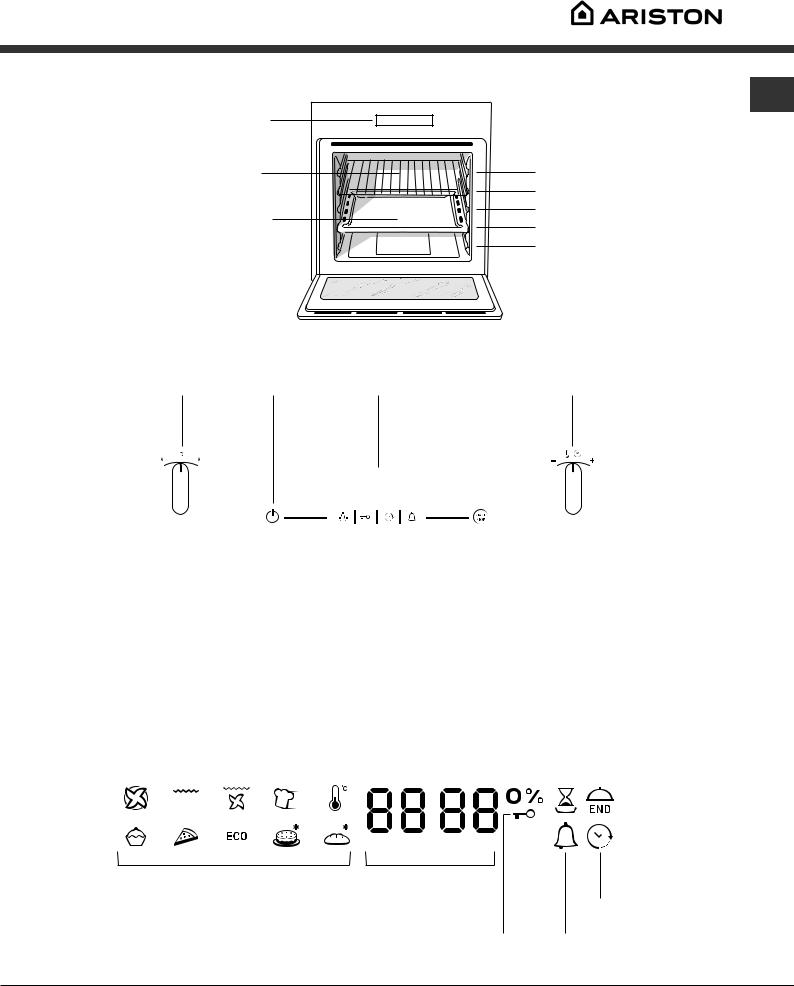
Description de l’appareil
Vue d’ensemble
FR
Tableau de bord |
GLISSIERES de |
|
|
coulissement |
|
Support GRILLE |
niveau 5 |
|
|
niveau 4 |
|
Support LECHEFRITE |
niveau 3 |
|
niveau 2 |
||
|
||
|
niveau 1 |
Tableau de bord
Bouton |
ALLUMAGE |
AFFICHEUR |
Bouton |
PROGRAMMES |
PANNEAU |
|
THERMOSTAT/ |
|
|
|
SÉLECTION TEMPS |
|
|
|
|
|
|
|
|
|
|
|
|
|
|
|
|
|
|
|
|
|
|
|
|
|
|
|
|
|
|
|
|
|
|
|
|
|
|
|
|
|
Icône |
|
|
|
|
|
|
|
DÉPART / |
ECLAIRAGE |
|
|
|
|
|
|
|
ARRÊT |
|
|
|
|
|||||||
|
Icône |
|
|
|
|
|
|
||
VERROUILLAGE COMMANDES |
|
|
|
|
|
|
|||
|
|
|
Icône |
|
|
Icône |
|||
|
SÉLECTION |
|
|
MINUTEUR |
|||||
|
|
|
TEMPS |
|
|
|
|
|
|
|
|
|
|
||||||
Afficheur
|
|
|
Chiffres TEMPÉRATURE |
|
|
|
|
|
Icône |
|
Icône |
|||||||
|
|
|
|
|
et TEMPS |
|
|
|
|
DURÉE |
|
FIN CUISSON |
||||||
|
|
|
|
|
|
|
|
|
|
|
|
|
|
|
|
|
|
|
|
|
|
|
|
|
|
|
|
|
|
|
|
|
|
|
|
|
|
|
|
|
|
|
|
|
|
|
|
|
|
|
|
|
|
|
|
|
|
|
|
|
|
|
|
|
|
|
|
|
|
|
|
|
|
|
|
|
|
|
|
|
|
|
|
|
|
|
|
|
|
|
|
|
|
|
|
|
|
|
|
|
|
|
|
|
|
|
|
|
|
|
|
|
|
|
|
|
|
|
|
|
|
|
|
|
|
|
|
|
|
|
|
|
|
|
|
|
|
|
|
|
|
|
|
|
|
|
|
|
|
|
|
|
|
|
|
|
|
|
|
|
|
|
|
|
|
|
|
|
|
|
Icônes |
|
Indicateur de |
|
Icône |
PROGRAMMES |
|
Préchauffage / |
|
HORLOGE |
|
|
|||
|
|
Chaleur résiduelle |
Voyant |
Icône |
|
|
|
||
|
|
CLAVIER VERROUILLÉ |
MINUTEUR |
|
19
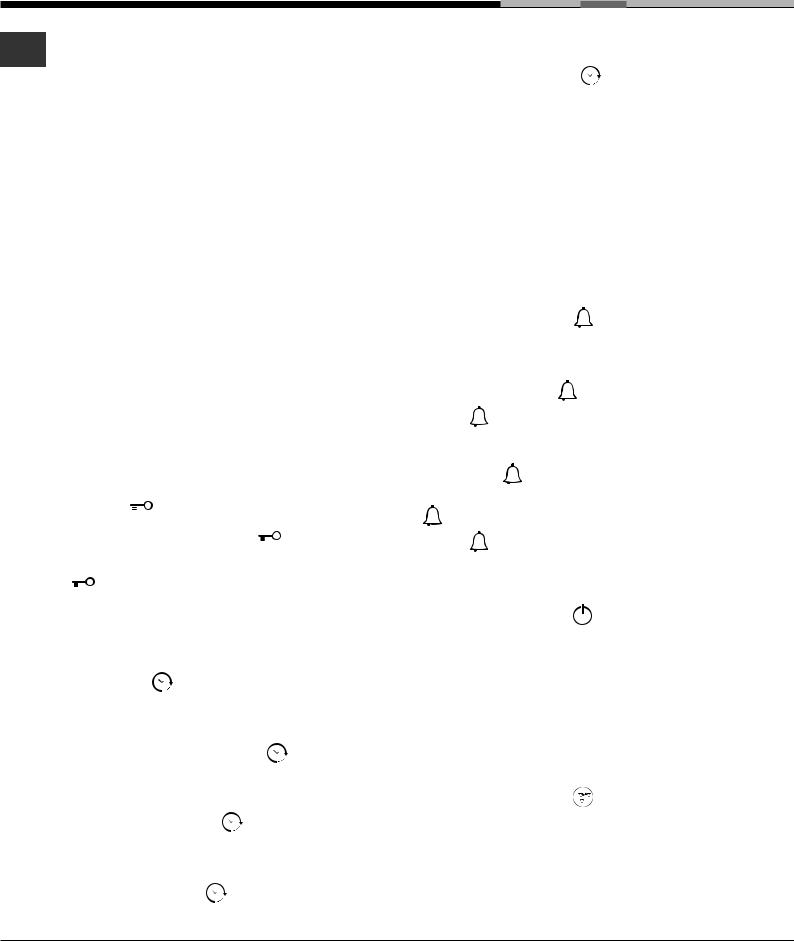
Mise en marche et utilisation
! Lors de son premier allumage, faire fonctionner le FR four à vide, porte fermée, pendant au moins une
heure en réglant le thermostat sur le maximum. Puis éteindre le four, ouvrir la porte et aérer la pièce. L’odeur qui se dégage est due à l’évaporation des produits utilisés pour protéger le four.
!Pour simplifier les sélections, garder le bouton en place : les chiffres défilent plus rapidement.
!Chaque sélection est automatiquement mémorisée pendant 10 secondes.
!Quand on porte les gants, il est impossible d'actionner les touches.
Certains modèles sont équipés d’un système de charnières qui permet à la porte de se fermer lentement sans devoir l’accompagner avec la main. Pour une bonne utilisation, avant de fermer :
•ouvrir complètement la porte.
•éviter de forcer manuellement la fermeture.
Verrouillage de commandes
! Les commandes peuvent être verrouillées four éteint, cuisson en cours ou terminée ou bien en programmation.
Pour verrouiller les commandes du four, appuyer sur la touche pendant au moins 2 secondes. Un signal sonore retentit et le symbole clé « n—O » apparaît sur l’afficheur la icône allumées indiquent que le verrouillage est activé.
Pour déverrouiller, appuyer à nouveau sur la touche pendant au moins 2 secondes.
Régler l’horloge
! L’horloge n’est réglable que four éteint. Si le four est en mode veille (standby), une première pression
sur la touche |
affiche l’heure courante. Appuyer à |
||
nouveau pour régler l’heure. |
|
|
|
Après branchement au secteur ou après |
|||
une panne de courant, la touche |
et les chiffres |
||
de l’afficheur se mettent à clignoter pendant 10 |
|||
secondes. |
|
|
|
Pour régler l’horloge : |
|
|
|
1. Appuyer sur la touche |
. |
|
|
2.tourner le bouton SÉLECTION TEMPS pour l’amener sur « + » ou « - » et régler l’heure.
3.Une fois l’heure exacte atteinte, appuyer à
nouveau sur la touche .
4. procéder comme sus-indiqué pour les minutes
aussi.
En cas de panne de courant, il faut remettre
l’horloge à l’heure. L’icône qui clignote sur l’afficheur signale que l’horloge a besoin d’être réglée.
Régler le minuteur
! Le minuteur est toujours réglable tant four éteint que four allumé. Il ne contrôle pas l’allumage et l’arrêt du four.
Une fois le temps écoulé, le minuteur émet un signal sonore qui s’arrête automatiquement au bout de 30 secondes ou après avoir appuyé sur une touche active quelconque.
Pour régler la minuterie :
1. Appuyer sur la touche |
. |
2.Régler la durée désirée en tournant le bouton SÉLECTION TEMPS sur « + » ou « - » .
3.Une fois la sélection voulue atteinte, appuyer à
nouveau sur la touche |
. |
|
L’icône |
allumée signale que le minuteur est |
|
activé. L’AFFICHEUR affiche le décompte.
Pour annuler la sélection de la minuterie, appuyer
sur la touche et à l’aide du bouton ramener le temps à 00:00. Appuyer à nouveau sur la touche
. |
|
L’icône |
éteinte signale que le minuteur est |
désactivé. |
|
Mise en marche du four
1. Appuyer sur la touche pour allumer le panneau de commande. L’appareil émet un triple son ascendant et toutes les touches s’allument à la suite.
2.Pour sélectionner le programme de cuisson souhaité, tourner le bouton PROGRAMMES. L’écran affiche :
- en cas de programme manuel, la température associée au programme ;
- en alternance « Auto » et la durée en cas de programme automatique.
3.Appuyer sur la touche  pour démarrer la cuisson.
pour démarrer la cuisson.
4.Le four se place en préchauffage, les indicateurs de montée en température s’éclairent progressivement au fur et à mesure que la température augmente.
5.Un signal sonore suivi de l’allumage de tous les indicateurs de préchauffage signale la fin du
20
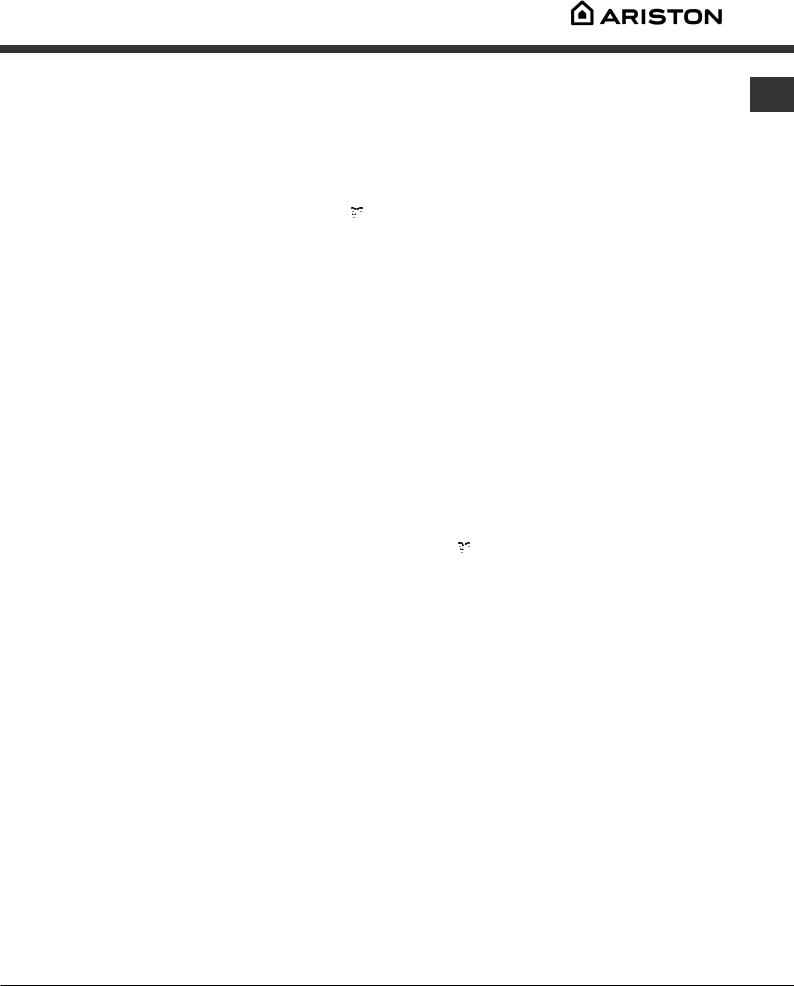
préchauffage. Il est temps d’enfourner les plats. 6. En cours de cuisson, il est possible à tout moment de :
- Modifier la température en tournant le bouton
THERMOSTAT (seuls programmes manuels) ;
-programmer la durée d’une cuisson (voir Programmes) ;
-stopper la cuisson en appuyant sur la touche  . Dans ce cas, l’appareil se rappelle de la température éventuellement modifiée précédemment (uniquement pour programmes manuels).
. Dans ce cas, l’appareil se rappelle de la température éventuellement modifiée précédemment (uniquement pour programmes manuels).
-éteindre le four en gardant la touche  enfoncée pendant 3 secondes.
enfoncée pendant 3 secondes.
7. En cas de coupure de courant, si la température du four n’est pas trop redescendue, un dispositif spécial fait repartir le programme à partir du moment où il a été interrompu. Les programmations en attente de démarrage ne sont par contre pas rétablies et doivent être reprogrammées dès rétablissement du courant (par exemple : un départ de cuisson a été programmé à 20h30. A 19h30, il y a une coupure de courant. Après rétablissement du courant, il faut reprogrammer).
!Aucun préchauffage n’est prévu pour le programme BARBECUE.
!Ne jamais poser d’objets à même la sole du four, l’émail risque de s’abîmer.
!Il faut toujours enfourner les plats sur la grille fournie avec l’appareil.
Ventilation de refroidissement
Pour obtenir un abaissement des températures extérieures, un système de refroidissement souffle de l’air à l’extérieur par une fente située entre le tableau de bord, la porte du four et la partie basse de la porte du four. En programme FAST COOKING le ventilateur s’active automatiquement dix minutes après le démarrage.
! Le ventilateur continue à tourner après l’arrêt du four jusqu’à ce que ce dernier se soit suffisamment refroidi.
Eclairage du four
FR
L’éclairage s’allume au démarrage d’un programme de cuisson.
En cas de modèles équipés de LED INSIDE, au démarrage de la cuisson les leds de la porte s’allument afin d’avoir un meilleur éclairage de tous les niveaux de cuisson.
La touche  permet d’allumer ou éteindre l’éclairage à tout moment.
permet d’allumer ou éteindre l’éclairage à tout moment.
Indicateurs de chaleur résiduelle
Cet appareil est équipé d’un indicateur de chaleur résiduelle. Four éteint, l’afficheur signale par allumage de la barre de “chaleur résiduelle” la présence de température à l’intérieur de l’enceinte. Les éléments de la barre s’éteignent au fur et à mesure que la température à l’intérieur du four baisse.
Rétablissement des réglages d’usine
Le four peut retourner à ses paramètres de réglage usine, il suffit pour cela de réinitialiser toutes les sélections effectuées par l’utilisateur (horloge et durées personnalisées). Pour procéder à la réinitialisation, éteindre le four, continuer à tourner le bouton PROGRAMMES dans le sens des aiguilles d’une montre et appuyer en mêe temps sur la
touche  pendant 6 secondes. Une fois que la réinitialisation a eu lieu, un signal sonore retentit.
pendant 6 secondes. Une fois que la réinitialisation a eu lieu, un signal sonore retentit.
Dès la première pression sur la touche  il y a retour à la première mise en service.
il y a retour à la première mise en service.
Standby
Ce produit est conforme à la nouvelle Directive européenne sur la réduction de la consommation d’énergie en mode standby. Sans opérations pendant 30 minutes et si aucun verrouillage de touches ou de porte n’a été sélectionné, l’appareil se place automatiquement en mode veille. Le mode standby est signalé par l’intense luminosité de l’“Icône horloge”. A la moindre intervention sur l’appareil, le système se remet en mode de fonctionnement normal.
21
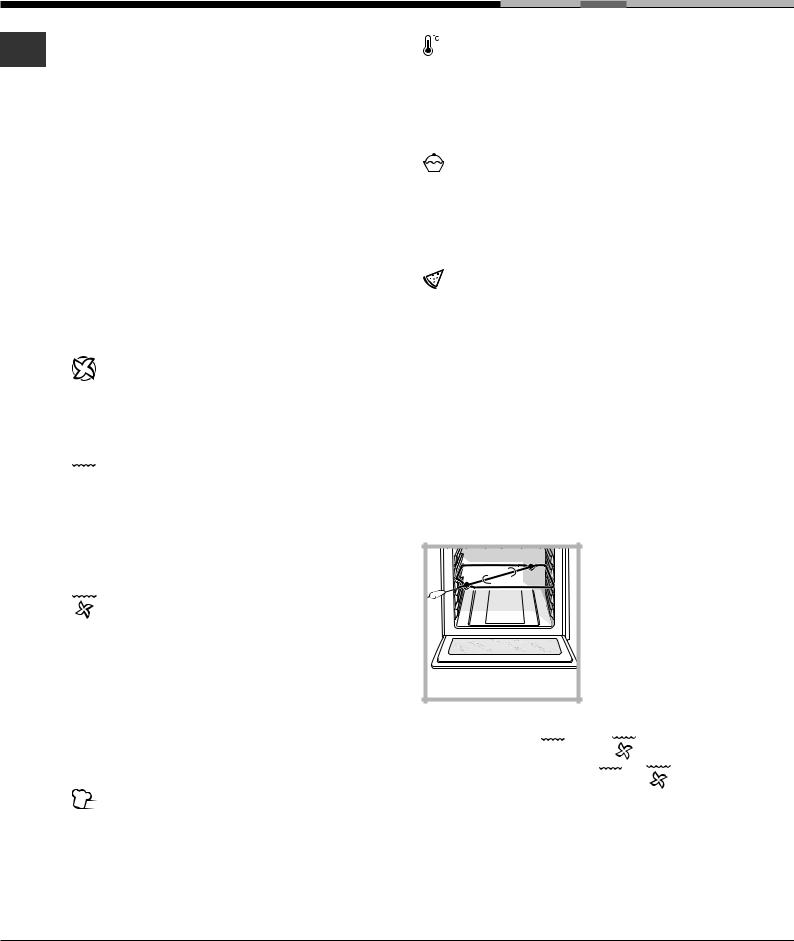
Programmes
! Pour obtenir des aliments parfaitement moelleux et FR croquants, l’humidité qu’ils dégagent est réutilisée
par le four sous forme de vapeur d’eau. Des résultats de cuisson optimaux sont ainsi obtenus pour tous les plats.
! A chaque allumage, le four propose le premier programme de cuisson manuel.
Programmes de cuisson manuels
! Tous les programmes ont une température de cuisson présélectionnée. Il est possible de la régler manuellement, entre 30 et 250°C au choix (300°C pour le programme BARBECUE). Toute modification de la température sera mémorisée et reproposée dès la prochaine utilisation du programme. Si la température choisie est supérieure à la température intérieure du four, l’écran affiche « Hot ». Il est toutefois possible de démarrer la cuisson.
Programme MULTINIVEAUX
La chaleur est constante et bien répartie à l’intérieur du four, l’air cuit et dore de façon uniforme en tous points. Il est possible de cuire au maximum sur deux niveaux en même temps.
Programme BARBECUE
Mise en marche de la résistance de voûte et du tournebroche (si l’appareil en est équipé). La température élevée et directe du gril est conseillée pour tous les aliments qui exigent une haute température en surface. La cuisson doit avoir lieu porte du four fermée
(voir « Conseils de cuisson »).
Programme GRATIN
Mise en marche de la résistance de voûte, de la résistance circulaire (pendant un certain temps) et de la turbine et du tournebroche (si l’appareil en est équipé). L’irradiation thermique unidirectionnelle s’ajoute au brassage de l’air pour une répartition uniforme de la chaleur dans l’enceinte du four.
Plus de risque de brûler les aliments en surface et plus grande pénétration de la chaleur. La cuisson doit avoir lieu porte du four fermée (voir « Conseils de cuisson »).
Programme FAST COOKING
Ce programme est tout particulièrement recommandé pour les cuissons rapides de plats préparés (surgelés ou précuits). Pour obtenir d’excellents résultats, n’enfourner que sur un seul niveau.
Programmes BASSE TEMPÉRATURE
Ce type de cuisson permet de faire lever les pâtes, de décongeler, de préparer du yaourt, de réchauffer plus ou moins rapidement et de cuire lentement à basse température. Températures sélectionnables : 40, 65, 90 °C.
ProgrammePÂTISSERIE
Mise en marche de la résistance arrière et de la turbine pour obtenir une chaleur douce et uniforme à l’intérieur du four. Cette fonction est particulièrement indiquée pour la cuisson de mets délicats (comme, par exemple, les gâteaux levés).
Programme PIZZA
Mise en marche de la résistance de voûte et de la résistance circulaire ainsi que de la turbine. Cette combinaison permet une montée en température rapide du four. En cas de cuisson sur plusieurs niveaux, ne pas oublier de les changer de place à mi-cuisson.
Programme ECO
Mise en marche de la résistance arrière et du ventilateur pour obtenir une chaleur douce et uniforme
à l’intérieur du four. Ce mode peu énergétique est recommandé pour les petits plats, il est idéal pour chauffer les aliments et finir la cuisson.
Tournebroche (n’existe que sur certains modèles)
Pour actionner le
tournebroche (voir figure),
procéder comme suit :
1. placer la lèchefrite
au niveau 1 ;
2. placer le berceau au niveau 3 et encastrer le
bout arrière de la broche dans le trou situé au fond de l’enceinte ;
3. brancher le tournebroche en amenant le sélecteur
PROGRAMMES sur |
ou sur |
|
; |
Quand les deux programmes |
ou |
sont |
|
lancés, le tournebroche s’arrête dès ouverture de la porte du four.
22
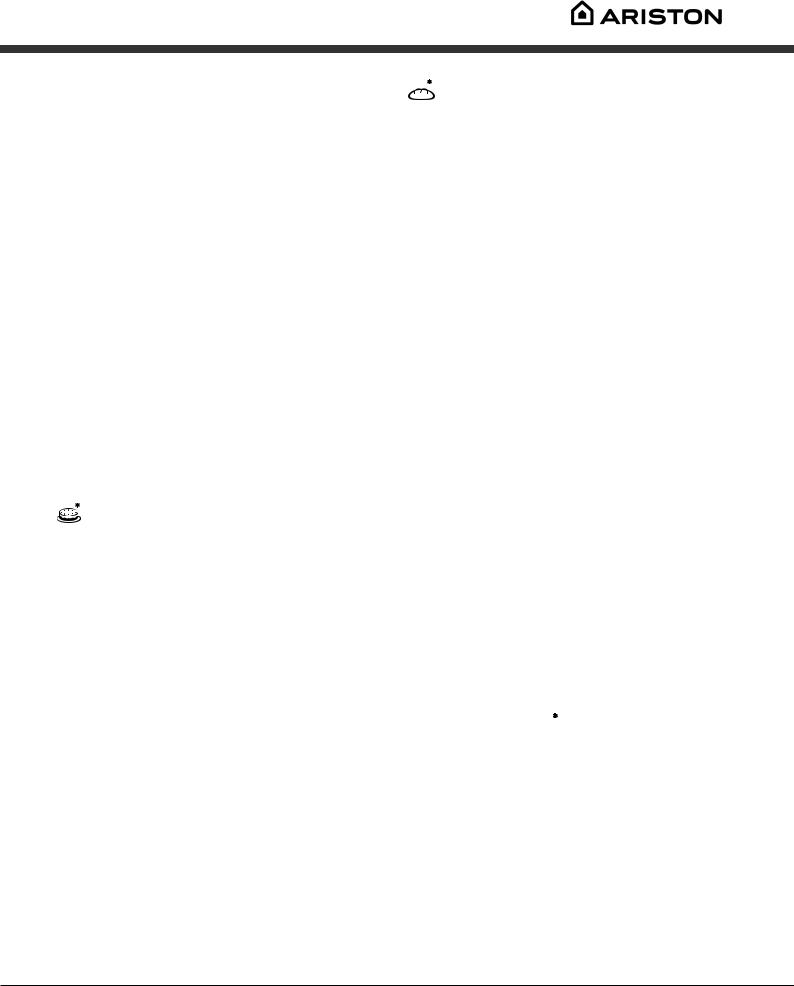
Programmes de cuisson automatiques
!La température et la durée de cuisson sont présélectionnées et ne peuvent pas être modifiées à l’aide du système C.O.P.® (Cuisson Optimale Programmée) qui garantit automatiquement un résultat parfait. La cuisson s’arrête automatiquement et le four signale que le plat est cuit. Il est possible d’enfourner à froid ou à chaud. Possibilité de personnaliser la durée de cuisson selon ses goûts personnels en la modifiant, avant le démarrage, de ±5/20 minutes selon le programme choisi. La modification de la durée est également possible en cours de cuisson. Si cette modification est effectuée avant le démarrage du programme, elle est mémorisée et reproposée dès la prochaine utilisation du programme. Si la température intérieure du four est supérieure à celle proposée par le programme choisi, l’écran affiche le message « Hot » et la cuisson ne peut pas être lancée : il faut attendre que le four refroidisse.
!Un bip signale que la cuisson est terminée.
!Pour éviter de fausser les temps de cuisson et de modifier les températures, ne pas ouvrir la porte du four.
Programme GÂTEAUX
Cette fonction est ce qu’il y a de mieux pour la cuisson de gâteaux à base de levure de boulanger, de levure chimique ou sans levure. Enfourner à froid. Il est aussi possible d’enfourner à chaud.
Programme PAIN |
FR |
C’est la fonction idéale pour la cuisson du pain. Pour |
|
|
|
obtenir de meilleurs résultats, nous recommandons de |
|
suivre attentivement les conseils suivants : |
|
•suivre la recette à la lettre ;
•respecter le poids maximal pour chaque plaque ;
•ne pas oublier de verser 50 g (0,5 dl) d’eau froide dans la lèchefrite au gradin 5 ;
•faire lever la pâte à température ambiante pendant 1 heure ou 1 heure et demie, selon la température de la pièce et jusqu’à ce qu’elle ait pratiquement doublé de volume.
Recette du PAIN :
1 Plaque de 1000g Maxi. gradin du bas
2 Plaques de 1000g Maxi. gradins du bas et du milieu
Recette pour 1000g de pâte : 600g de farine, 360g d’eau, 11g de sel, 25g de levure de boulanger fraîche (ou bien 2 sachets en poudre)
Procédé :
•Mélanger la farine et le sel dans un grand récipient.
•Diluer la levure de boulanger dans de l’eau légèrement tiède (35 degrés environ).
•Disposer la farine en fontaine.
•Verser le mélange d’eau et de levure
•Mélanger et pétrir jusqu’à obtenir une pâte homogène et peu collante, l’étirer avec la paume de la main et la replier sur elle-même pendant 10 minutes.
•Former une boule, la placer dans un saladier et couvrir d’un film plastique pour éviter que la surface de la pâte ne sèche. Glisser le saladier dans le four, sélectionner la fonction manuelle BASSE TEMPERATURE à 40°C et laisser lever environ 1 heure (la pâte doit doubler de volume)
•Diviser la boule pour obtenir plusieurs pains.
•Les placer sur la plaque du four recouverte de papier sulfurisé.
•Saupoudrer les pains de farine.
•Pratiquer des entailles sur les pains.
•Enfourner à froid.
•Démarrer la cuisson PAIN
PAIN
•En fin de cuisson, laisser reposer les pains sur une grille jusqu’à ce qu’ils aient complètement refroidi.
23
